Indoor vines are a fantastic way to bring nature into your home, adding a touch of elegance and freshness to any room. These versatile plants can drape gracefully from shelves, climb walls, or cascade from hanging baskets, creating a lush, inviting atmosphere. In this comprehensive guide, we’ll explore 35 stunning indoor vine ideas to inspire your green thumb and elevate your home decor.
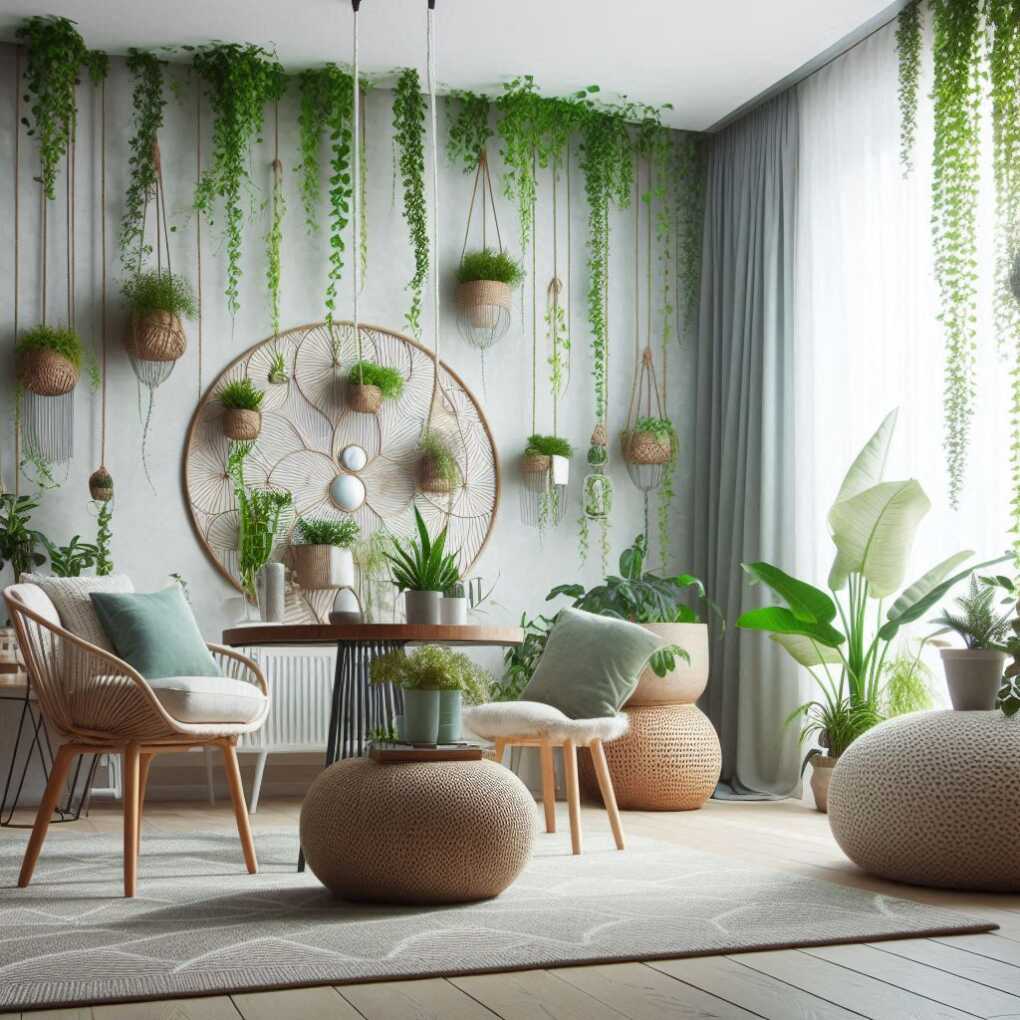
Why Choose Indoor Vines?
Before we dive into our list of vine ideas, let’s consider the benefits of incorporating these plants into your home:
- Air purification
- Stress reduction
- Improved humidity
- Visual appeal
- Space-saving greenery
“In the world of interior design, indoor vines are the unsung heroes, capable of transforming a space from ordinary to extraordinary with their lush, cascading beauty.” – Emma Green, Interior Design Expert
Now, let’s explore our 35 indoor vine ideas, categorized by their care requirements and optimal growing conditions.
1. Pothos (Epipremnum aureum)
The classic trailing vine, pothos is renowned for its easy care and ability to thrive in a variety of indoor conditions. Its heart-shaped leaves come in shades of green, yellow, and even variegated patterns, making it a versatile choice for shelves, hanging baskets, or even cascading from high surfaces.
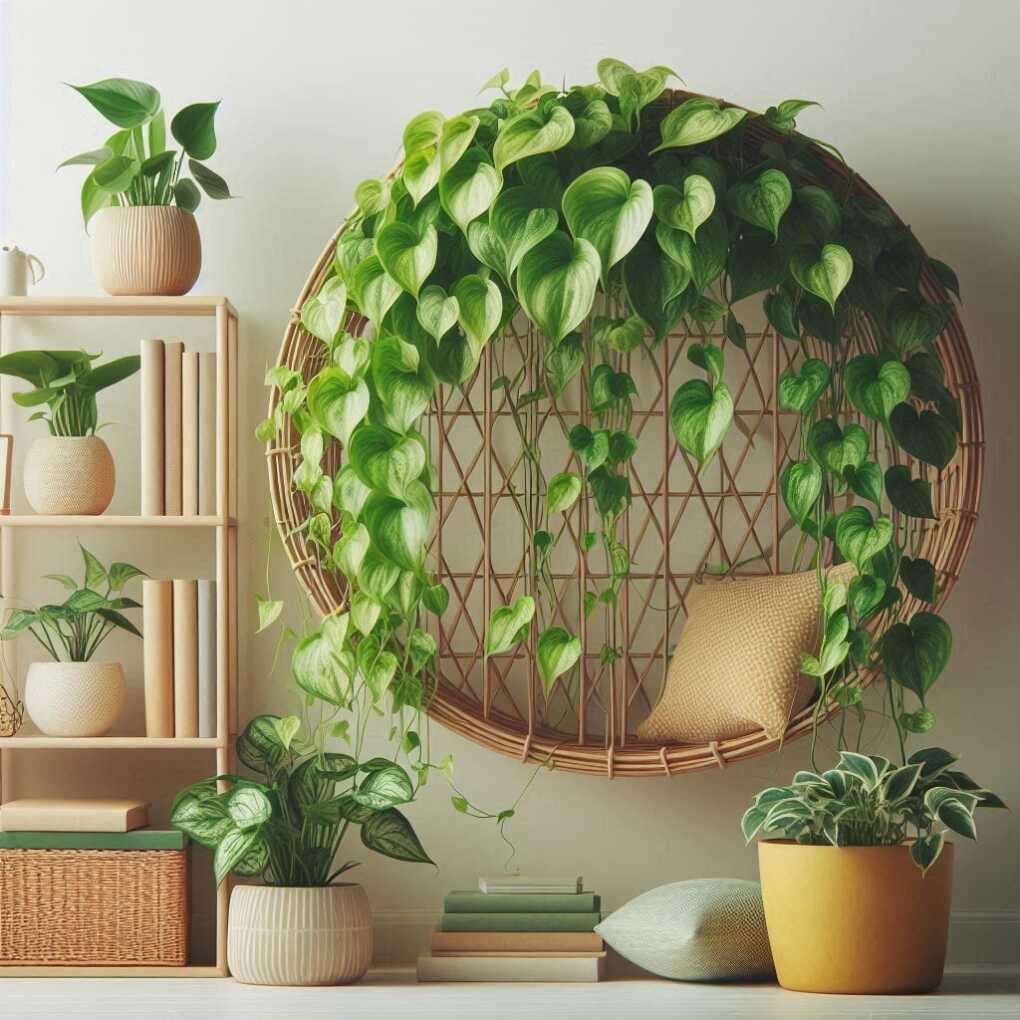
Pro Tip: To encourage fuller growth, pinch off the growing tips regularly. This will promote branching and create a bushier appearance.
Commercial Product: Costa Farms Golden Pothos
2. English Ivy (Hedera helix)
Elegant and sophisticated, English ivy is a popular choice for indoor vine displays. Its delicate, lobed leaves create a lush, trailing effect that can be trained to climb up trellises, adorn mantles, or spill over the edges of planters.
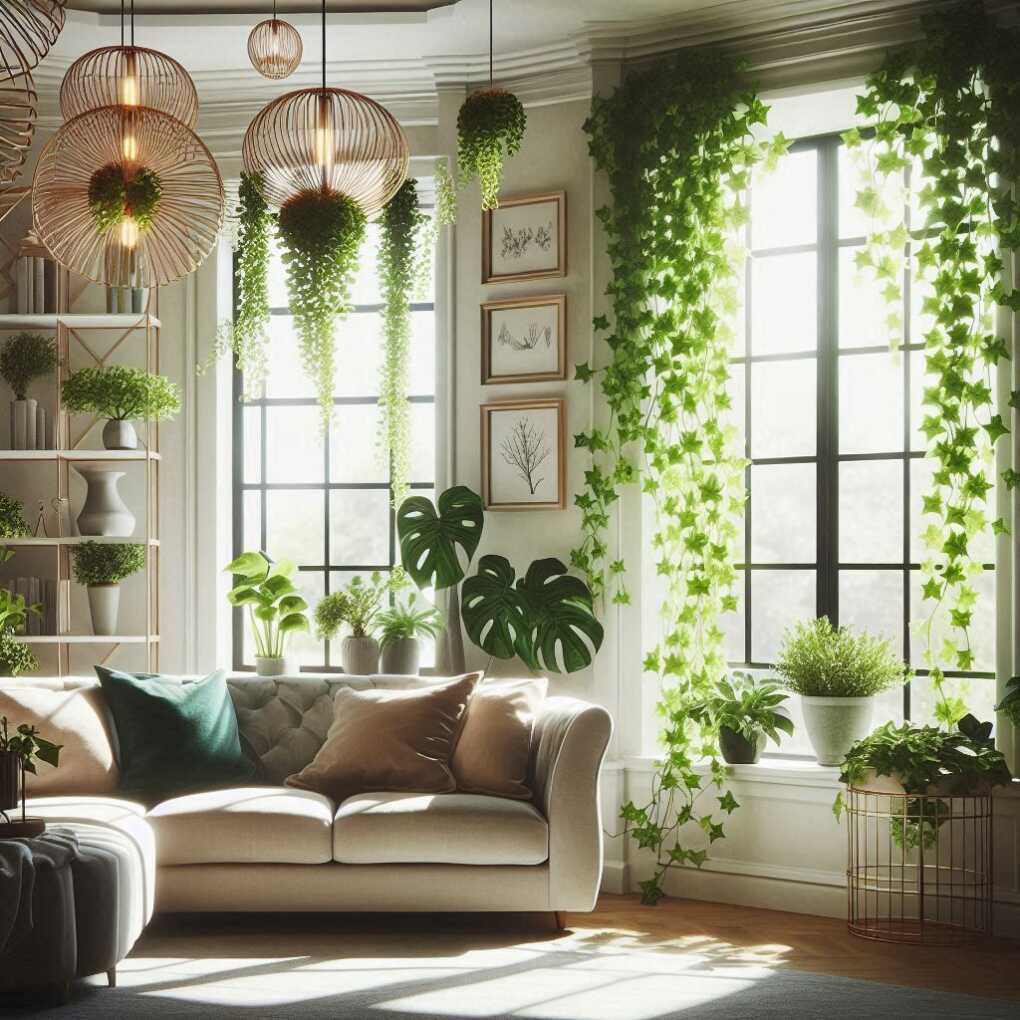
Indoor Styling Ideas:
- Create a living wall by training English ivy on a wire mesh frame
- Use it as a natural curtain by hanging it in front of windows
- Wrap it around a circular hoop for a stunning wreath-like display
Pro Tip: English ivy prefers cooler temperatures and high humidity. Mist the leaves regularly to keep them healthy and vibrant.
3. String of Pearls (Senecio rowleyanus)
Unique and whimsical, the string of pearls plant features a cascade of small, round succulent leaves that resemble a string of pearls. This low-maintenance vine is perfect for hanging baskets, shelves, or even as a centrepiece in a terrarium.
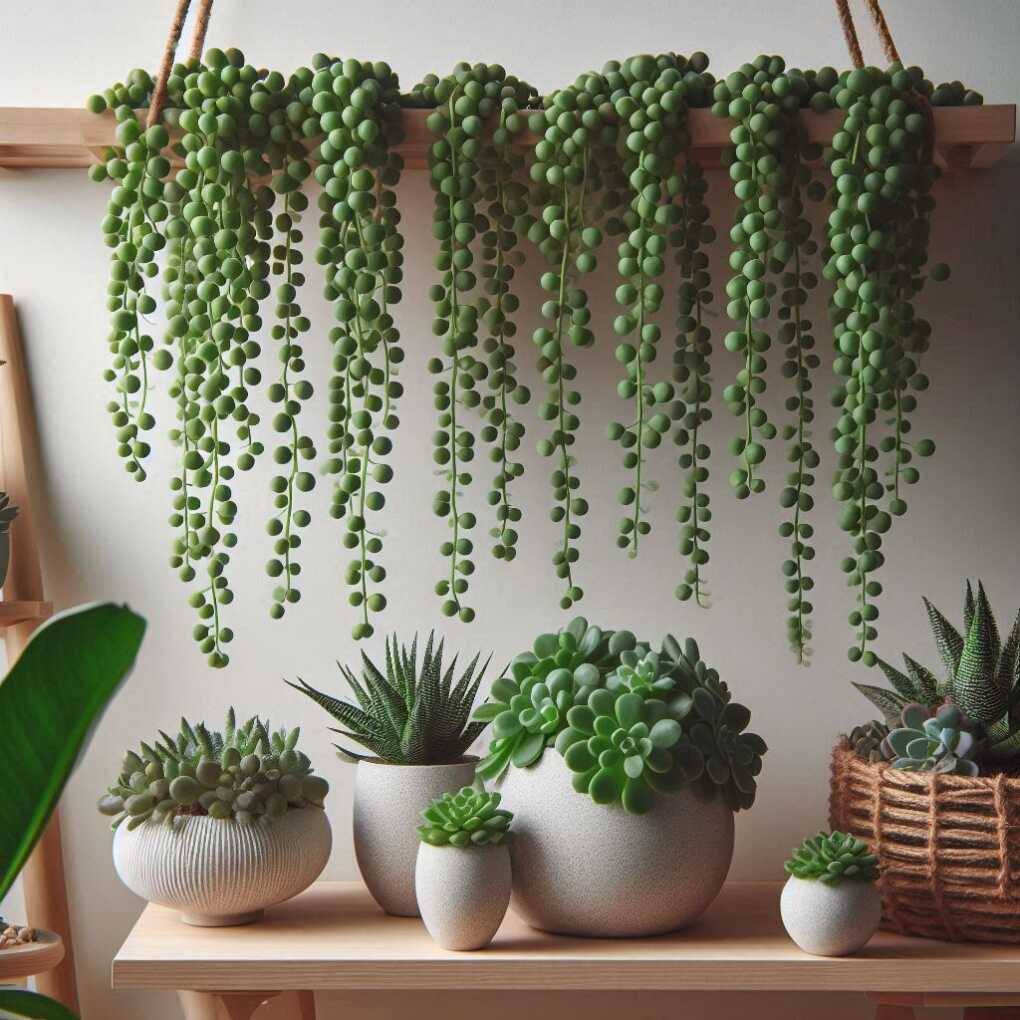
Care Instructions:
- Light: Bright, indirect light
- Water: Allow soil to dry between waterings
- Soil: Well-draining succulent mix
- Temperature: 70-80°F (21-27°C)
Pro Tip: To propagate a string of pearls, simply cut a strand and place it on top of moist soil. The nodes will root, creating new plants.
Commercial Product: Hirt’s Gardens String of Pearls Plant
4. Philodendron (Philodendron spp.)
With their large, glossy leaves and trailing vines, philodendrons are a classic choice for indoor greenery. From the heart-shaped leaves of the heartleaf philodendron to the split-leaf varieties, these plants add a tropical flair to any space.
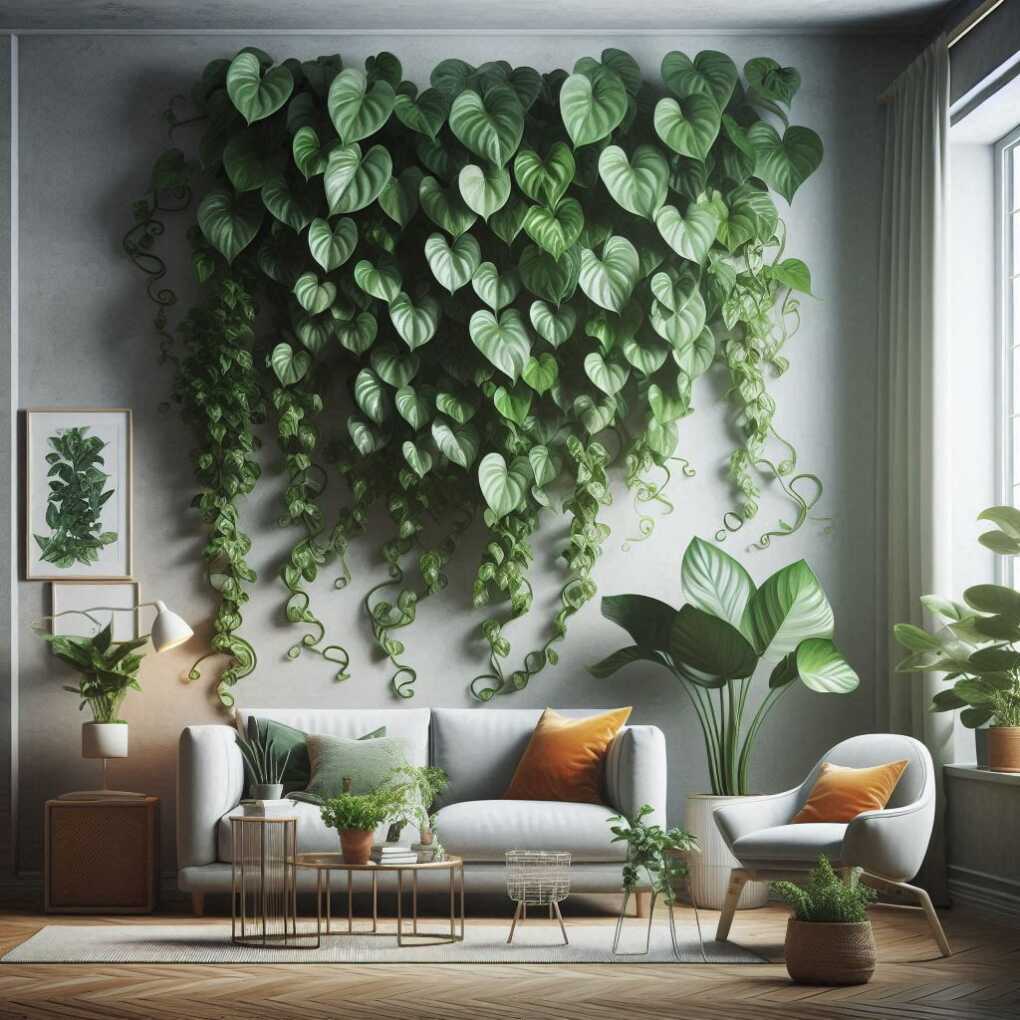
Popular Philodendron Varieties:
- Heartleaf Philodendron (Philodendron hederaceum)
- Brasil Philodendron (Philodendron hederaceum ‘Brasil’)
- Velvet Leaf Philodendron (Philodendron micans)
- Silver Sword Philodendron (Philodendron hastatum)
Pro Tip: To encourage fuller growth, train your philodendron to climb a moss pole. This mimics their natural growing habit and can result in larger, more impressive leaves.
5. Tradescantia (Tradescantia spp.)
Also known as wandering jew or spiderwort, tradescantia vines feature vibrant, striped foliage that cascades beautifully from hanging baskets or shelves. These low-maintenance plants come in a range of colours, including purple, green, and variegated varieties.
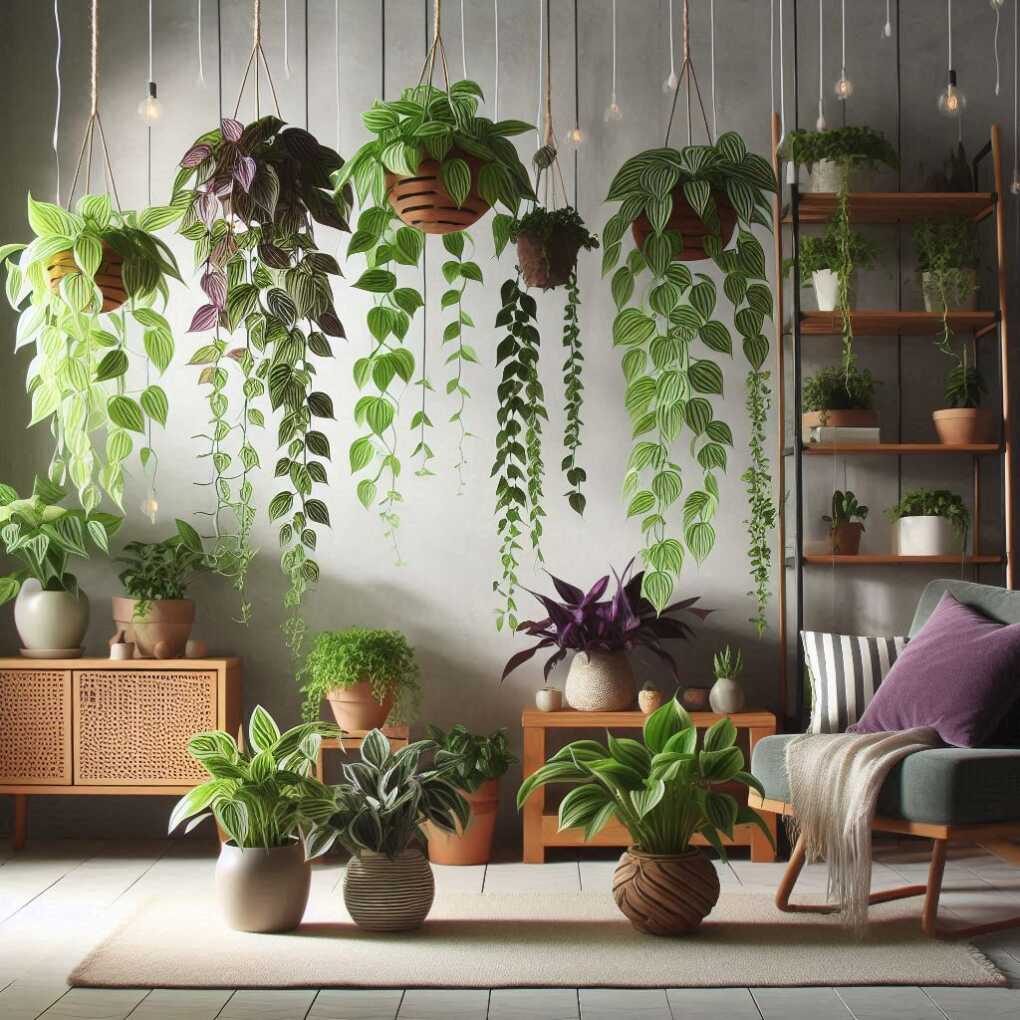
Tradescantia Color Varieties:
- Purple Queen (Tradescantia pallida ‘Purpurea’)
- Zebrina (Tradescantia zebrina)
- Tricolor (Tradescantia fluminensis ‘Tricolor’)
Pro Tip: To maintain vibrant colors, especially in variegated varieties, ensure your tradescantia receives plenty of bright, indirect light.
Commercial Product: American Plant Exchange Wandering Jew
6. Hoya (Hoya spp.)
Hoya, or wax plant, is a stunning indoor vine with thick, waxy leaves and delicate, star-shaped flowers. These plants can be trained to climb trellises or allowed to trail gracefully from shelves and planters.
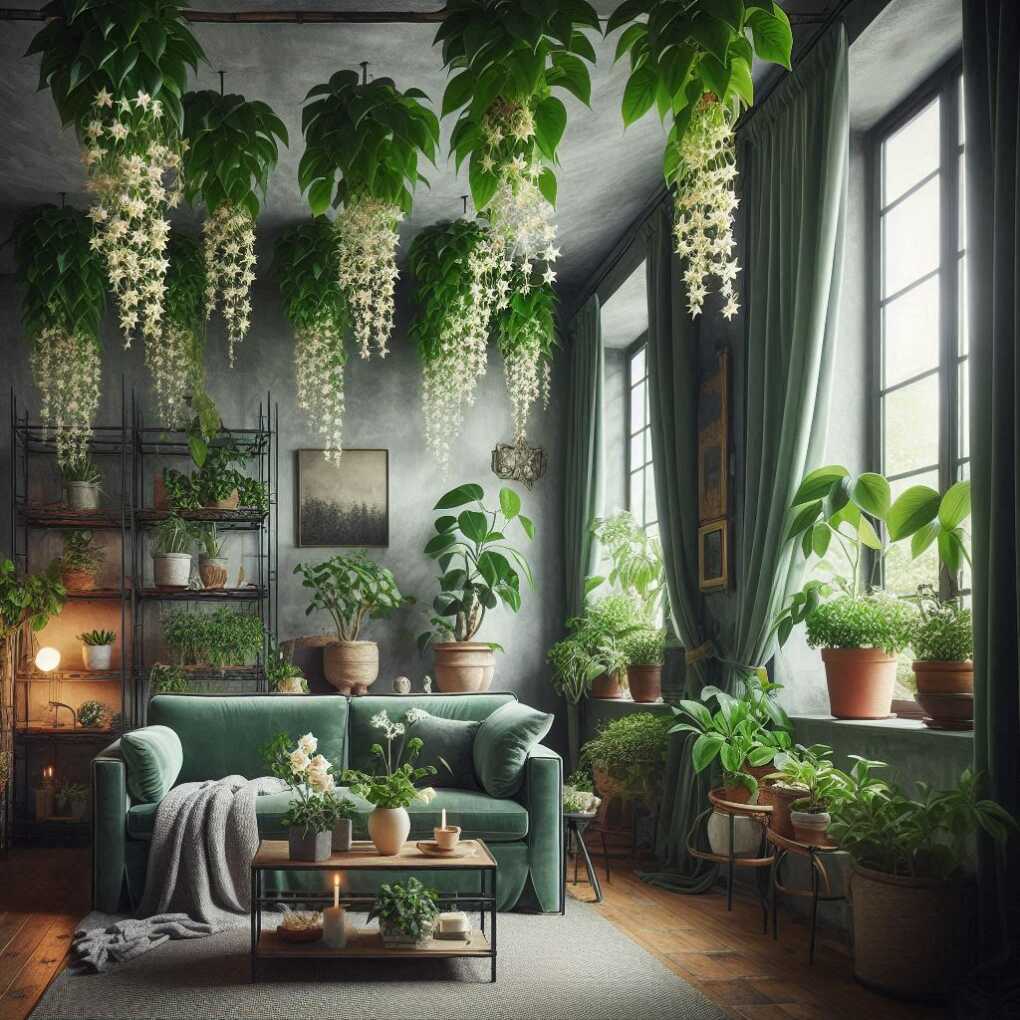
Popular Hoya Species:
- Hoya carnosa (Wax Plant)
- Hoya kerrii (Sweetheart Hoya)
- Hoya obovata (Clover Hoya)
- Hoya linearis (String Bean Hoya)
Pro Tip: Hoyas prefer to be slightly root-bound to encourage blooming. Only repot when absolutely necessary, and use a pot just slightly larger than the current one.
7. Peperomia (Peperomia spp.)
Peperomia vines, with their unique, textured leaves, add a touch of whimsy to any indoor space. From the round, coin-like leaves of the peperomia prostrata to the trailing, heart-shaped varieties, these plants are easy to care for and come in a range of colors and patterns.
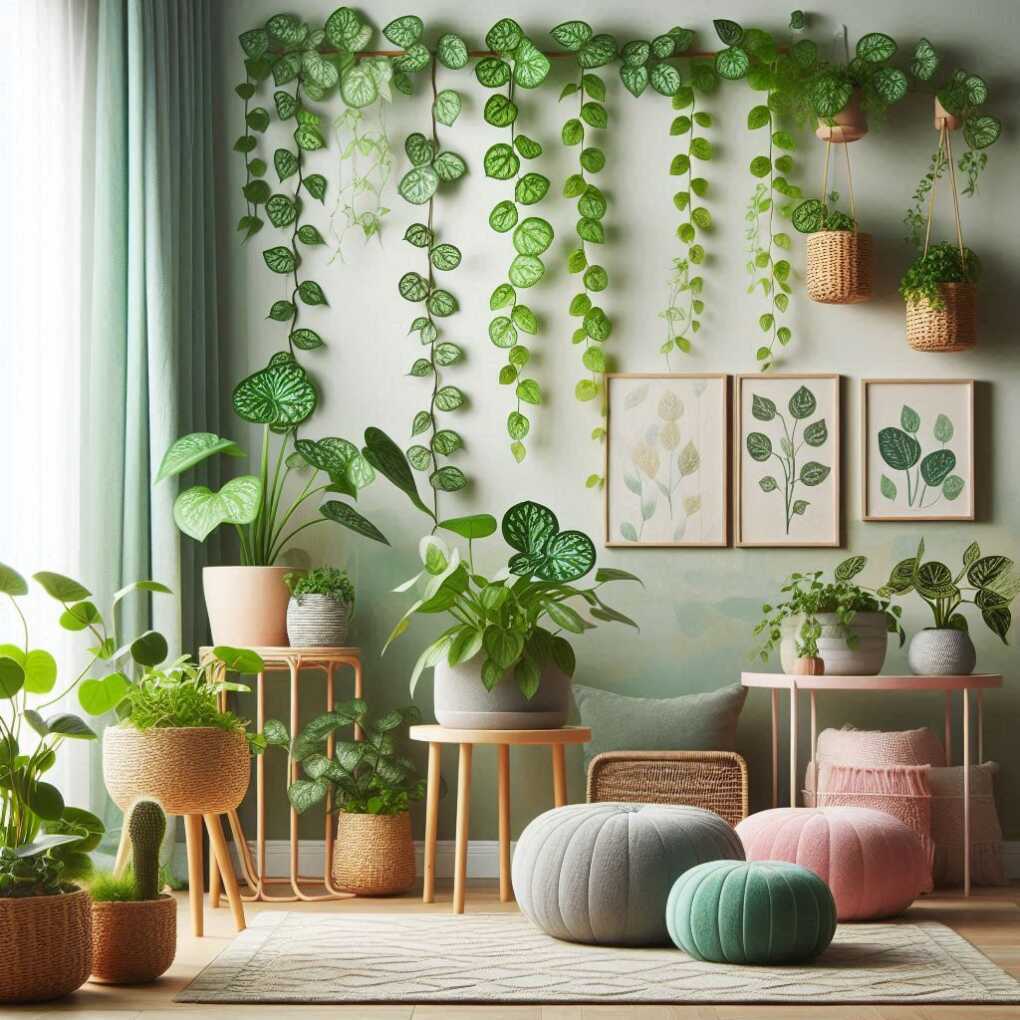
Peperomia Styling Ideas:
- Create a mini jungle terrarium with various peperomia species
- Use trailing varieties in kokedama (Japanese moss balls)
- Mix different peperomia types in a single planter for a diverse display
Pro Tip: Many peperomia species are epiphytes in their natural habitat. Use a well-draining, airy potting mix to mimic these conditions and prevent root rot.
Commercial Product: Costa Farms Peperomia Collection
8. Monstera Deliciosa
The iconic Swiss cheese plant, Monstera deliciosa, is a must-have for any indoor jungle enthusiast. Its large, perforated leaves and climbing vines make it a statement piece that can be trained to climb up a trellis or cascade from a high shelf.
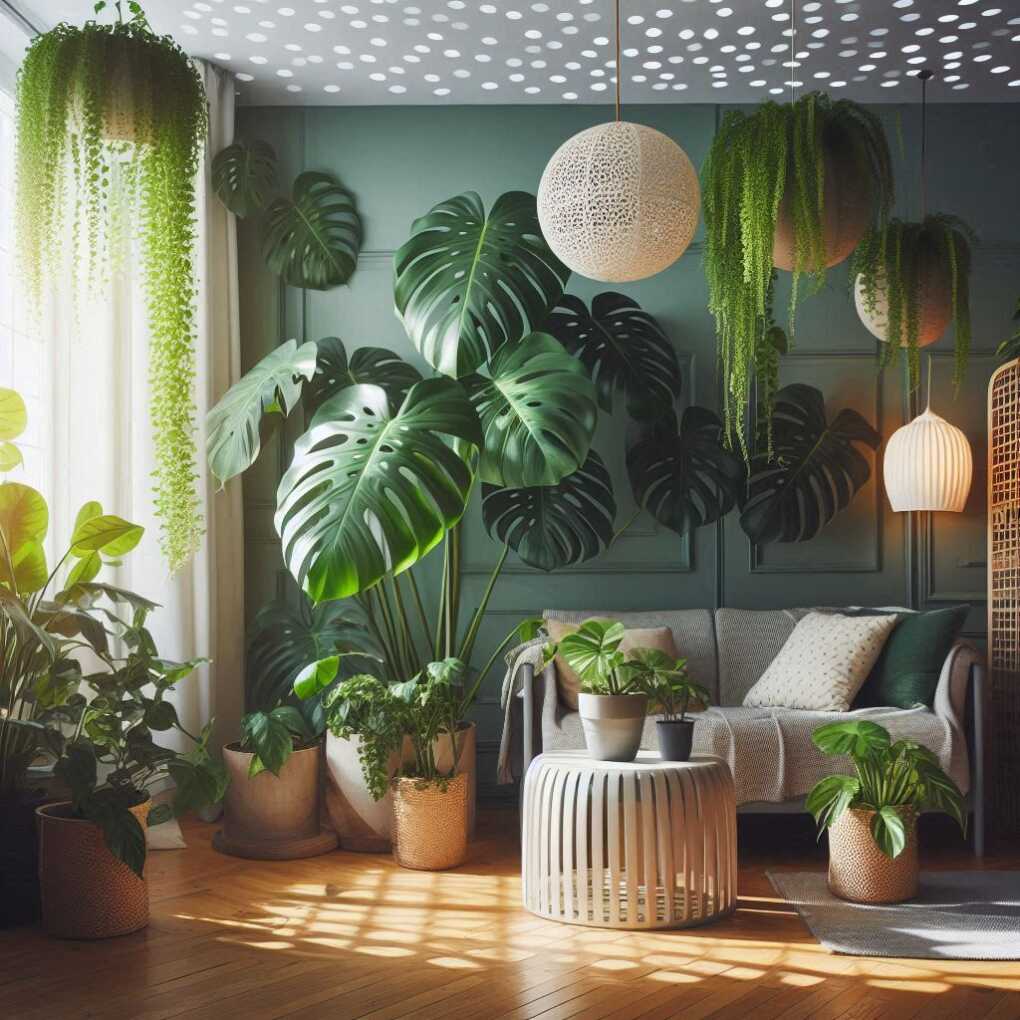
Monstera Care Tips:
- Light: Bright, indirect light
- Water: Allow top inch of soil to dry between waterings
- Humidity: Moderate to high
- Support: Provide a moss pole or trellis for climbing
Pro Tip: To encourage larger leaves with more fenestrations (holes), ensure your Monstera receives plenty of indirect light and support for climbing.
9. Burro’s Tail (Sedum morganianum)
The burro’s tail, with its long, trailing stems and plump, succulent leaves, is a captivating addition to any indoor vine display. This low-maintenance plant thrives in bright, indirect light and can be grown in hanging baskets or on shelves.
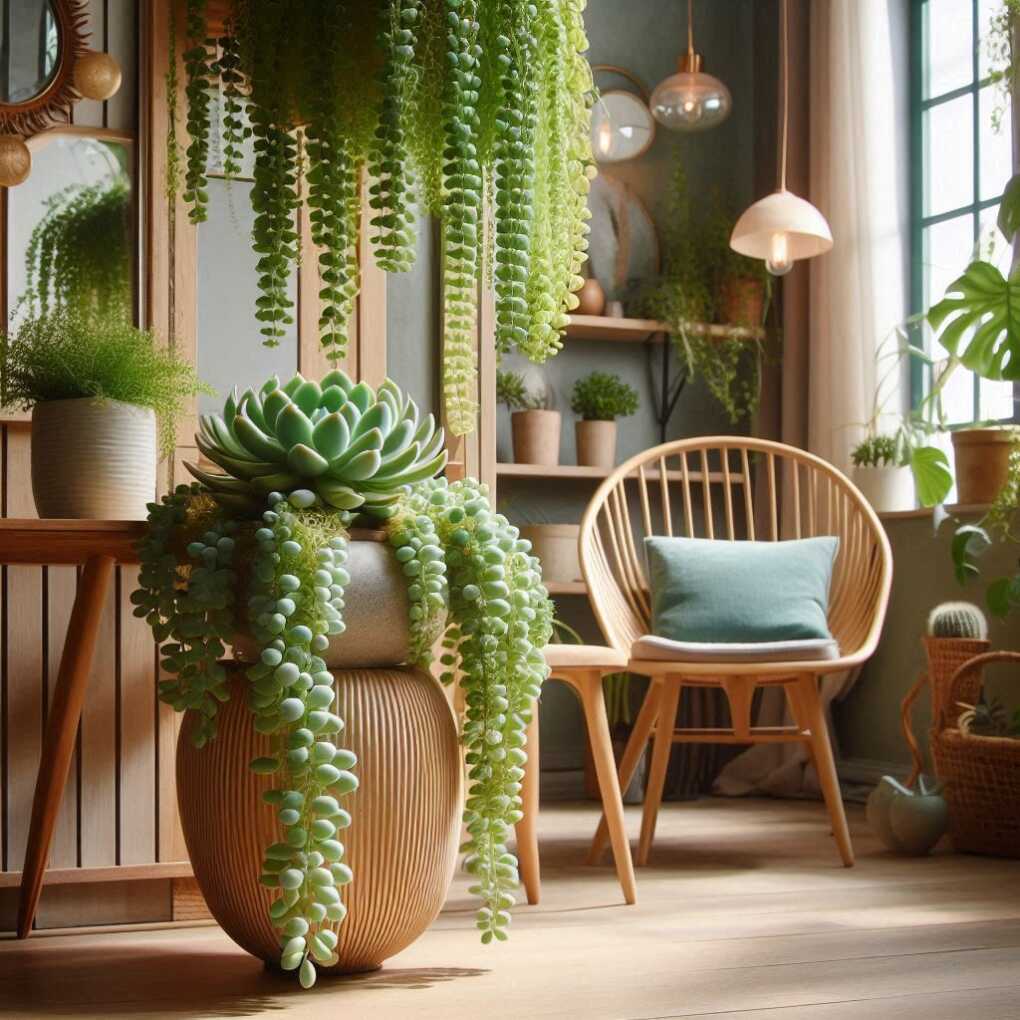
Propagation Method:
- Gently remove a few leaves from the stem
- Allow the leaves to callous over for a day or two
- Place the leaves on top of well-draining cactus soil
- Mist occasionally until roots form
Pro Tip: Handle burro’s tail with care, as the leaves can easily fall off. When watering, avoid getting water on the leaves to prevent rot.
Commercial Product: Altman Plants Assorted Live Succulents
10. Lipstick Plant (Aeschynanthus spp.)
The lipstick plant is a vibrant, trailing vine with waxy, tubular flowers that resemble lipstick. These plants add a touch of tropical flair to any indoor space and can be trained to climb or allowed to cascade from shelves and planters.
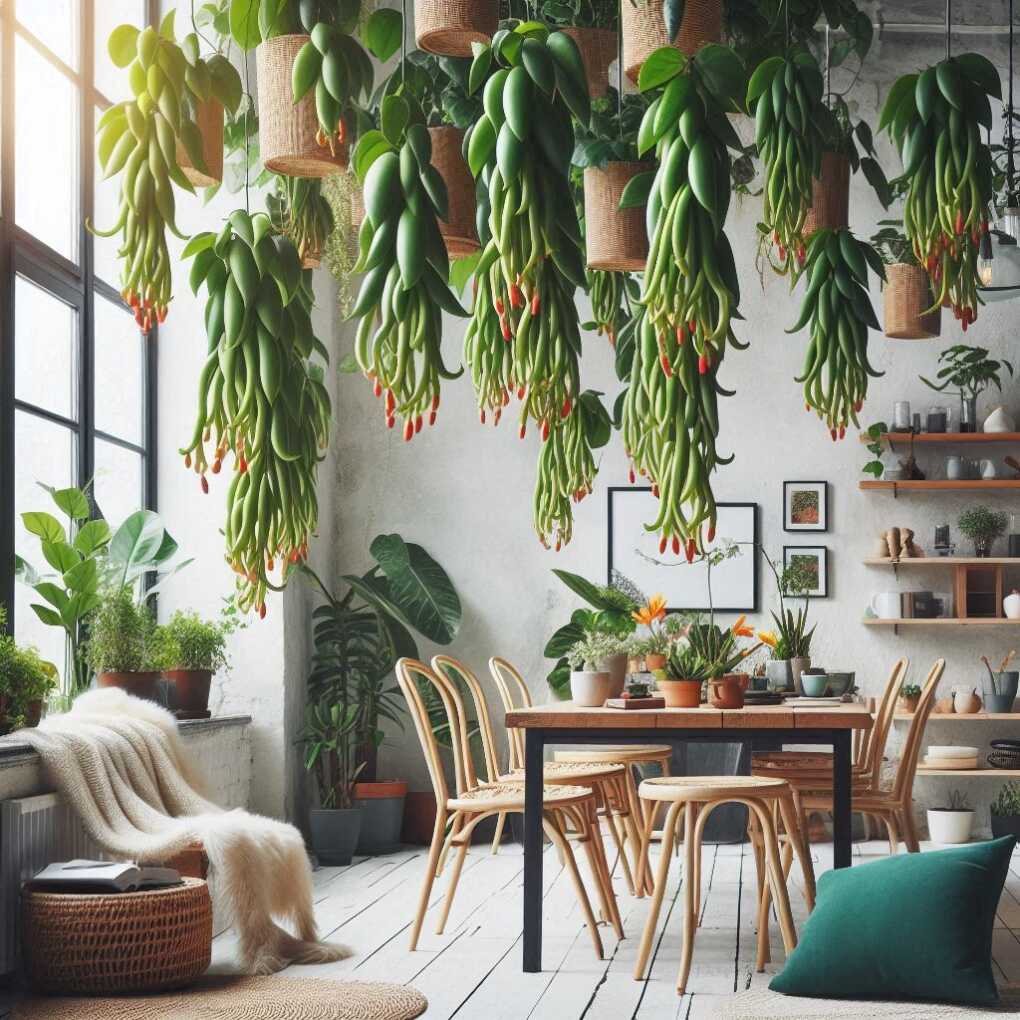
Blooming Tips:
- Provide bright, indirect light
- Maintain high humidity
- Allow the soil to dry slightly between waterings
- Feed with a balanced, water-soluble fertilizer during the growing season
Pro Tip: To encourage more frequent blooming, slightly reduce watering and fertilizing during the winter months, then resume normal care in spring.
11. Dischidia (Dischidia spp.)
Dischidia, also known as the Hindu rope plant, is a unique and eye-catching indoor vine. Its long, trailing stems are adorned with small, succulent-like leaves that create a mesmerizing, cascading effect.
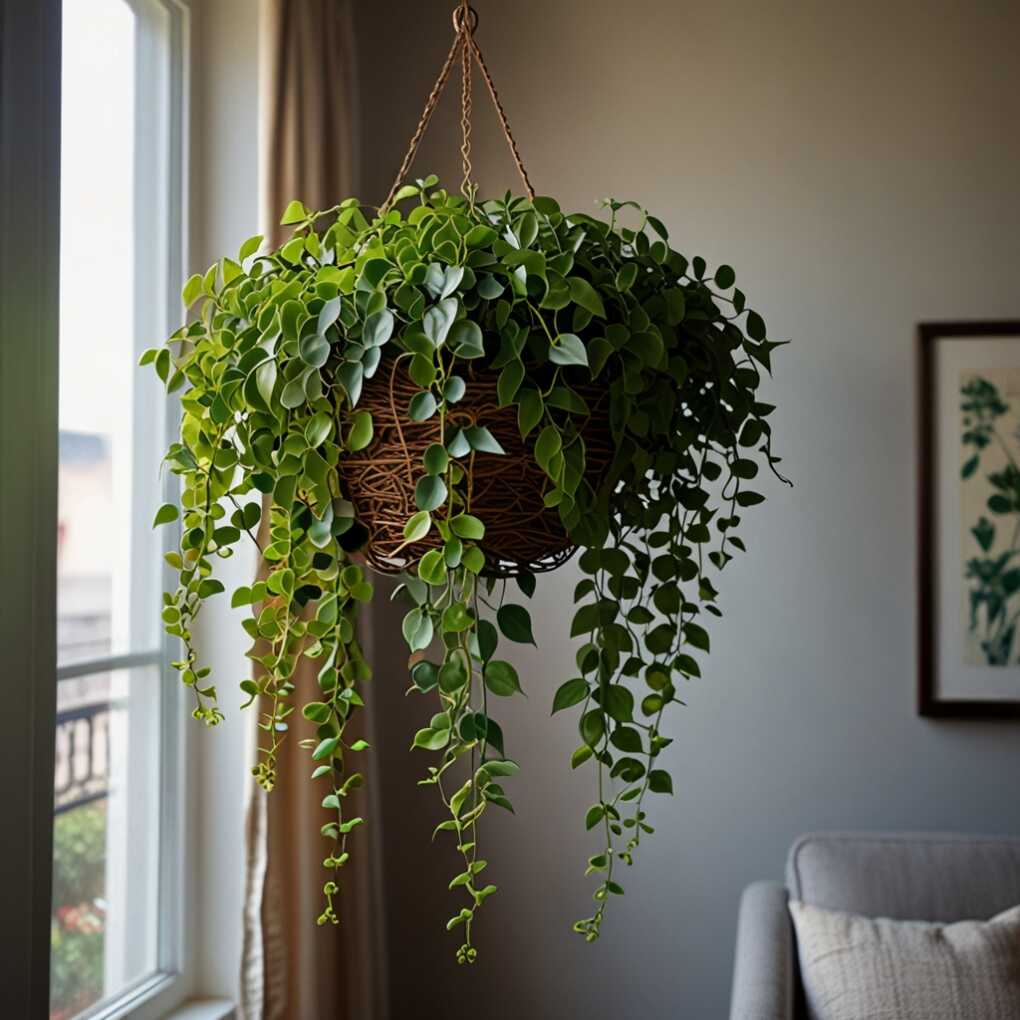
Popular Dischidia Species:
- Dischidia nummularia (String of Nickels)
- Dischidia ruscifolia (Million Hearts)
- Dischidia ovata (Watermelon Dischidia)
Pro Tip: Dischidias are epiphytes in nature, so they prefer to grow on bark or in hanging baskets with well-draining soil. Consider mounting them on cork bark for a natural display.
Commercial Product: Hirt’s Gardens Dischidia Million Hearts Plant
12. Rhipsalis (Rhipsalis spp.)
Rhipsalis, or mistletoe cactus, is a fascinating indoor vine with segmented, trailing stems and small, delicate flowers. These plants thrive in bright, indirect light and can be displayed in hanging baskets or on shelves.
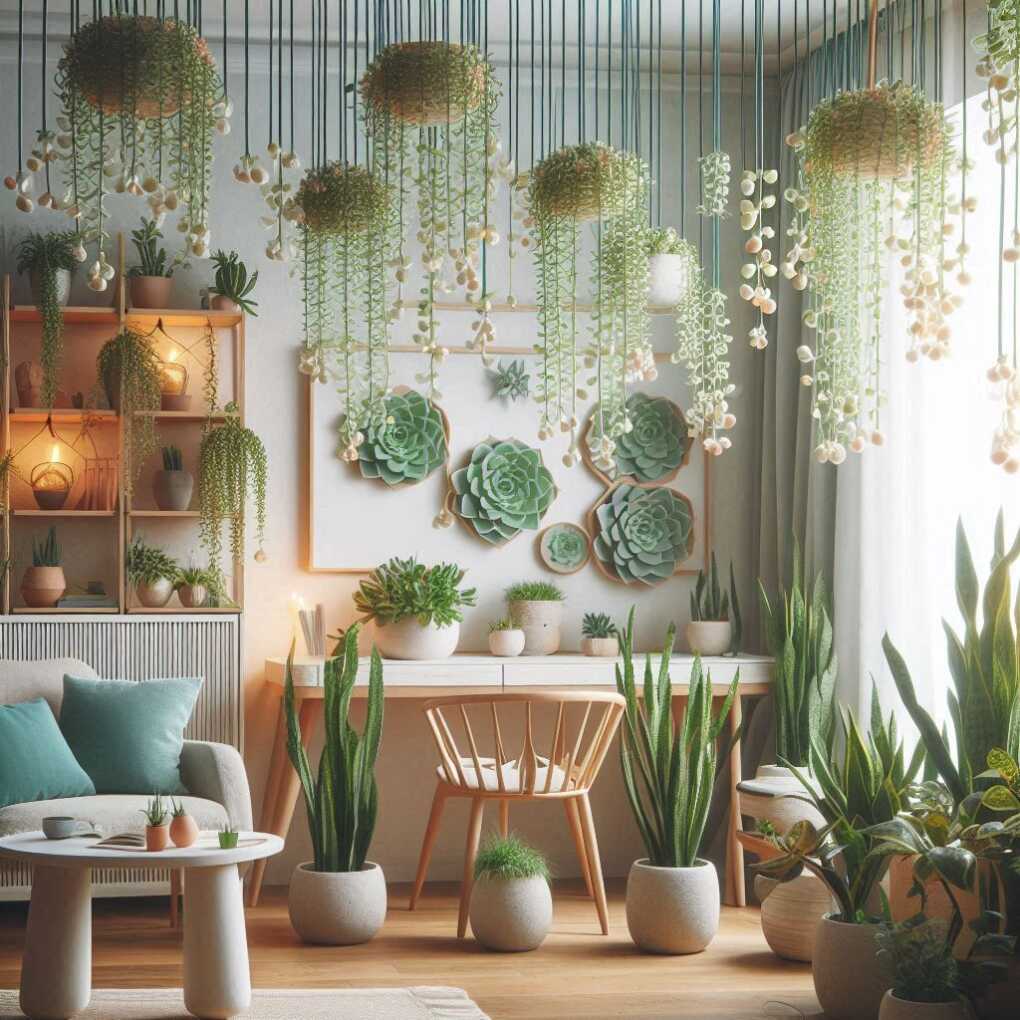
Rhipsalis Care Guide:
- Light: Bright, indirect light
- Water: Allow soil to dry between waterings
- Soil: Well-draining cactus mix
- Humidity: Moderate to high
Pro Tip: Rhipsalis can be sensitive to overwatering. When in doubt, err on the side of underwatering, especially during winter months.
13. Senecio Rowleyanus (String of Pearls)
The string of pearls plant is a whimsical and low-maintenance indoor vine. Its trailing stems are dotted with small, round, succulent-like leaves that resemble a string of pearls, making it a charming addition to any space.
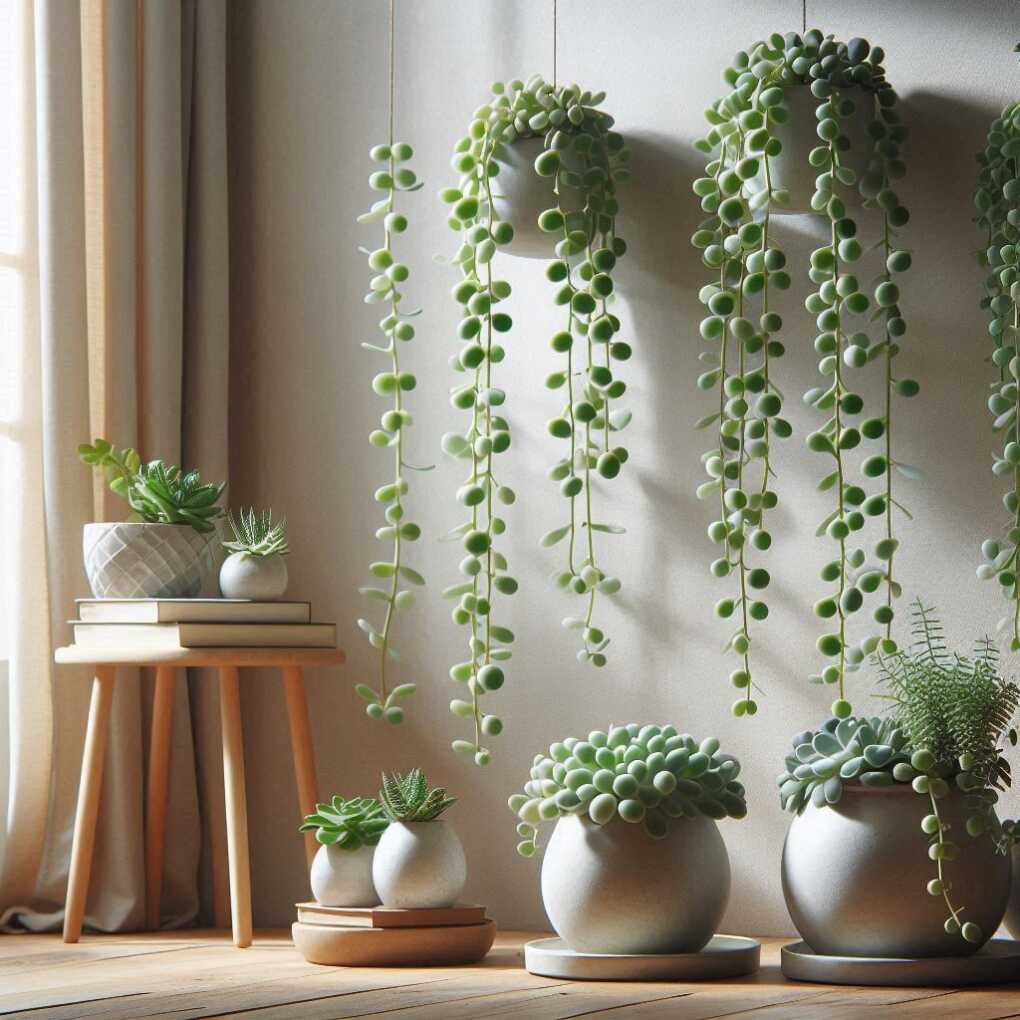
Creative Display Ideas:
- Hang in a macramé plant hanger
- Trail over the edges of a floating shelf
- Create a living curtain by hanging multiple plants in a row
Pro Tip: To keep your string of pearls full and lush, periodically trim long strands and replant them in the same pot to fill in bare spots.
Commercial Product: Succulents Box String of Pearls Plant
14. Ceropegia Woodii (String of Hearts)
The string of hearts, with its heart-shaped leaves and trailing vines, is a delightful indoor vine that adds a touch of romance to any room. This plant thrives in bright, indirect light and can be displayed in hanging baskets or on shelves.
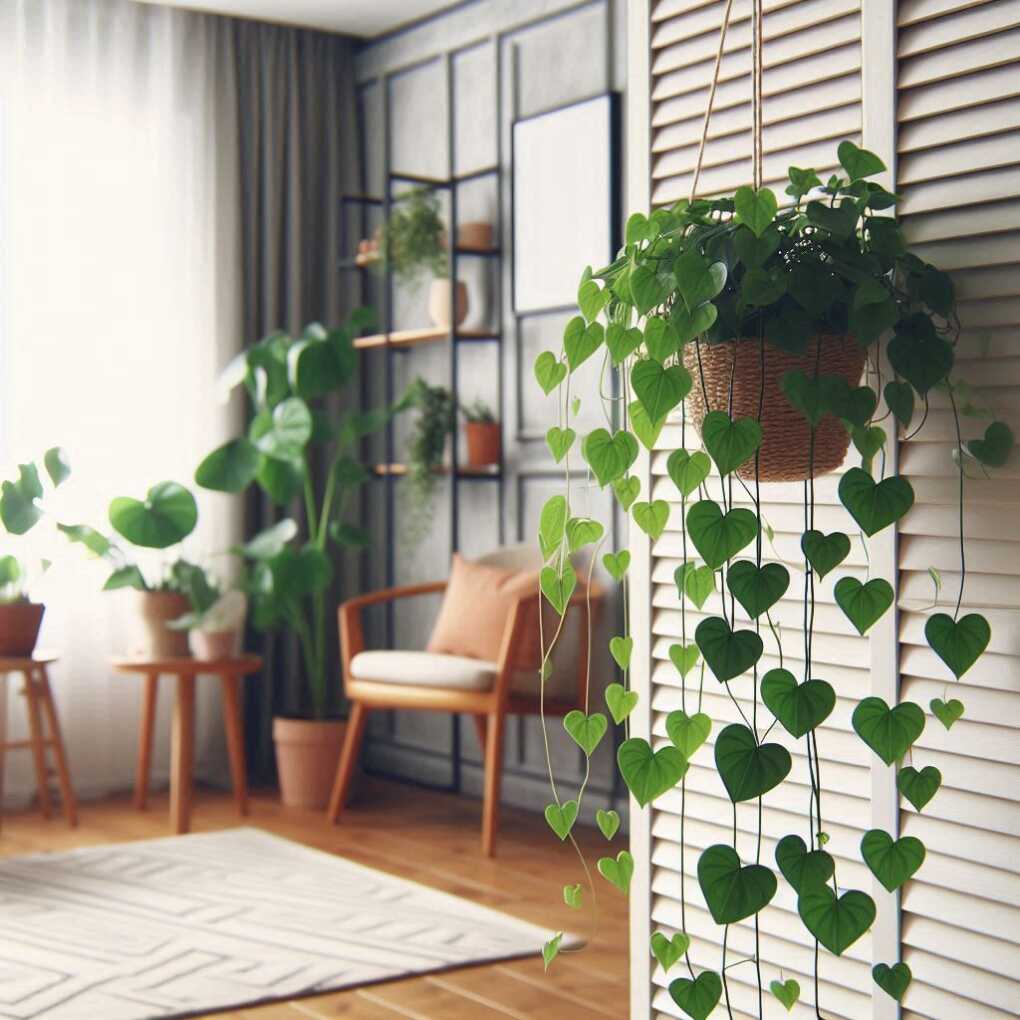
Variegated Varieties:
- ‘Silver Glory’ – silvery-green leaves with dark green edges
- ‘Pink Dragon’ – pink and green variegated leaves
- ‘Variegata’ – cream and green variegated leaves
Pro Tip: To encourage fuller growth, coil some of the longer vines back into the pot. They will root and create a bushier appearance.
15. Tradescantia Zebrina (Wandering Jew)
The wandering jew, with its vibrant, striped foliage and trailing vines, is a versatile and easy-to-grow indoor vine. It can be trained to climb or allowed to cascade from shelves, baskets, or even macrame hangers.
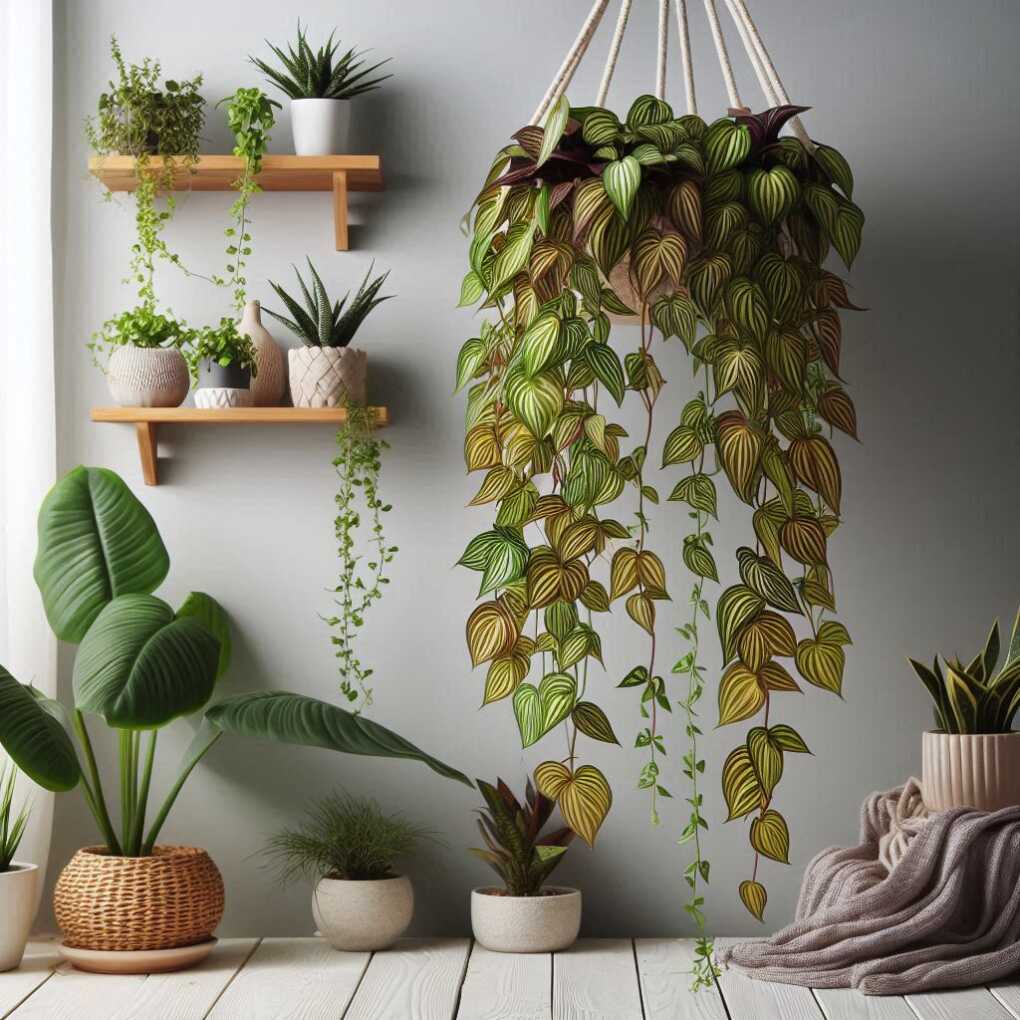
Colour Variations:
- Purple and silver stripes
- Green and white stripes
- Pink and green stripes
Pro Tip: To maintain vibrant colors, especially in variegated varieties, ensure your Tradescantia receives plenty of bright, indirect light. Pinch back regularly to encourage bushier growth.
Commercial Product: Josh’s Frogs Wandering Jew Plant
16. Hoya Carnosa (Wax Plant)
The wax plant, or hoya, is a stunning indoor vine with thick, waxy leaves and delicate, star-shaped flowers. These plants can be trained to climb trellises or allowed to trail gracefully from shelves and planters.
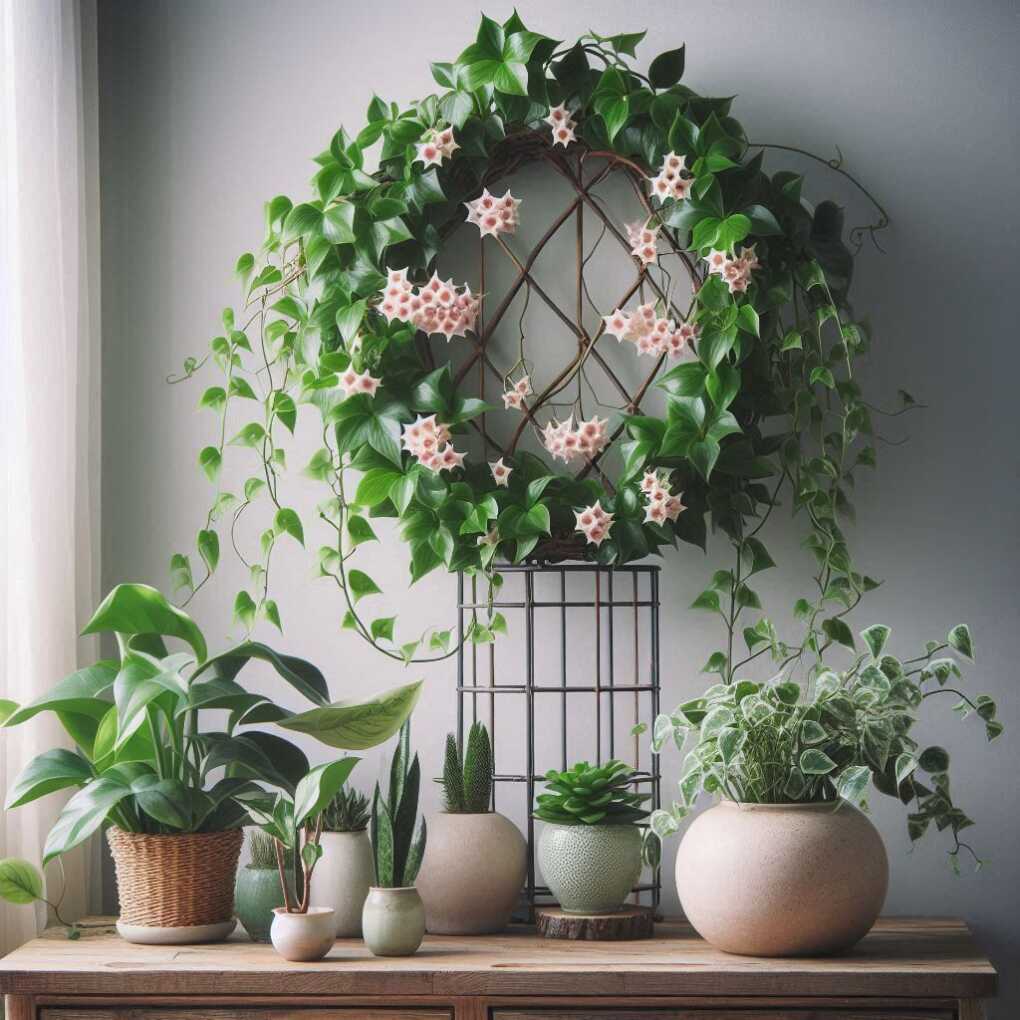
Popular Hoya Carnosa Varieties:
- ‘Krimson Queen’ – white-edged leaves
- ‘Compacta’ – curled, rope-like leaves
- ‘Rubra’ – red-tinged leaves
- ‘Variegata’ – cream and green variegated leaves
Pro Tip: Hoyas bloom best when slightly root-bound. Avoid repotting too frequently and only move to a slightly larger pot when absolutely necessary.
17. Scindapsus Pictus (Silver Satin Pothos)
The silver satin pothos, with its silvery-green, heart-shaped leaves and trailing vines, is a beautiful and low-maintenance indoor vine. It thrives in bright, indirect light and can be displayed in hanging baskets or on shelves.
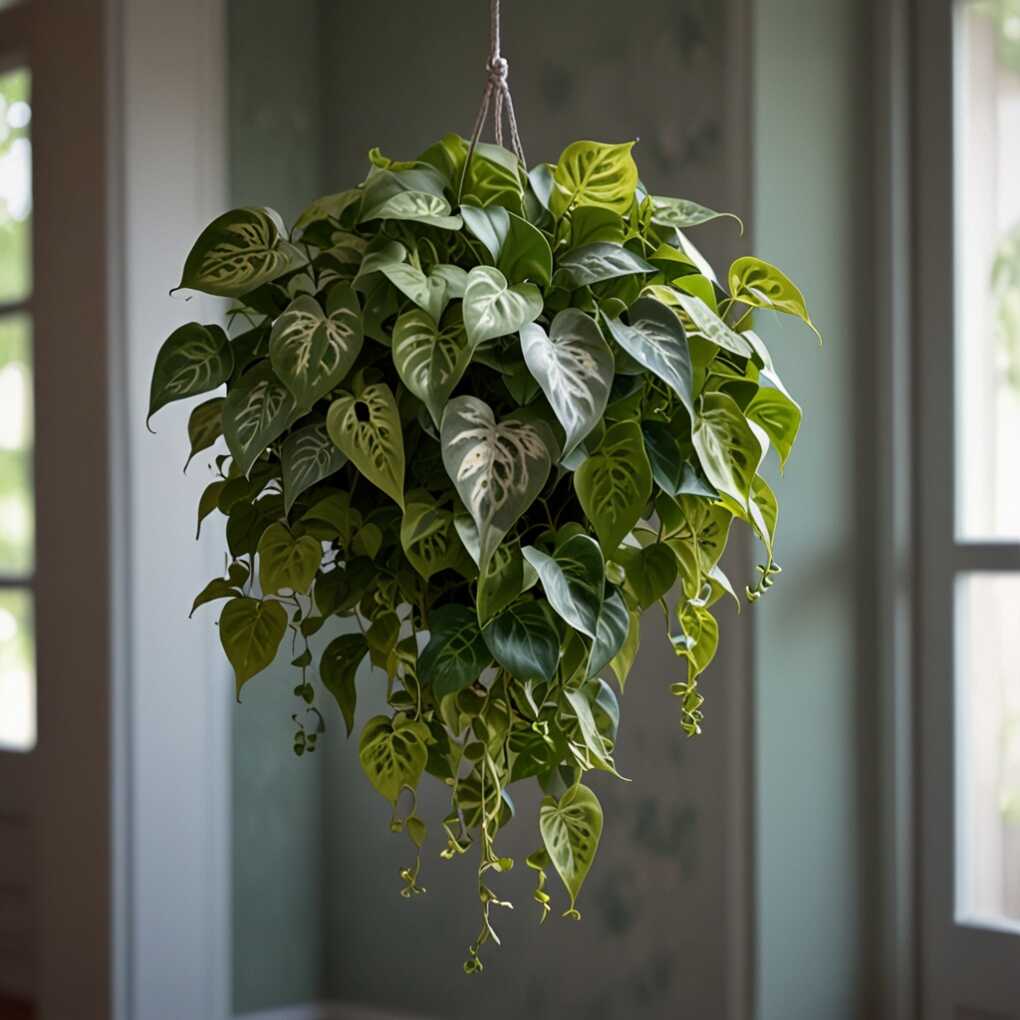
Care Instructions:
- Light: Medium to bright indirect light
- Water: Allow top inch of soil to dry between waterings
- Soil: Well-draining potting mix
- Humidity: Moderate to high
Pro Tip: To maintain the silvery sheen on the leaves, avoid getting water on the foliage when watering. Clean the leaves gently with a damp cloth if they become dusty.
Commercial Product: Costa Farms Satin Pothos
18. Epipremnum Aureum (Golden Pothos)
The classic golden pothos is a resilient and easy-to-grow indoor vine. Its vibrant, heart-shaped leaves and trailing vines make it a popular choice for adding greenery to any space, from shelves and mantles to hanging baskets.
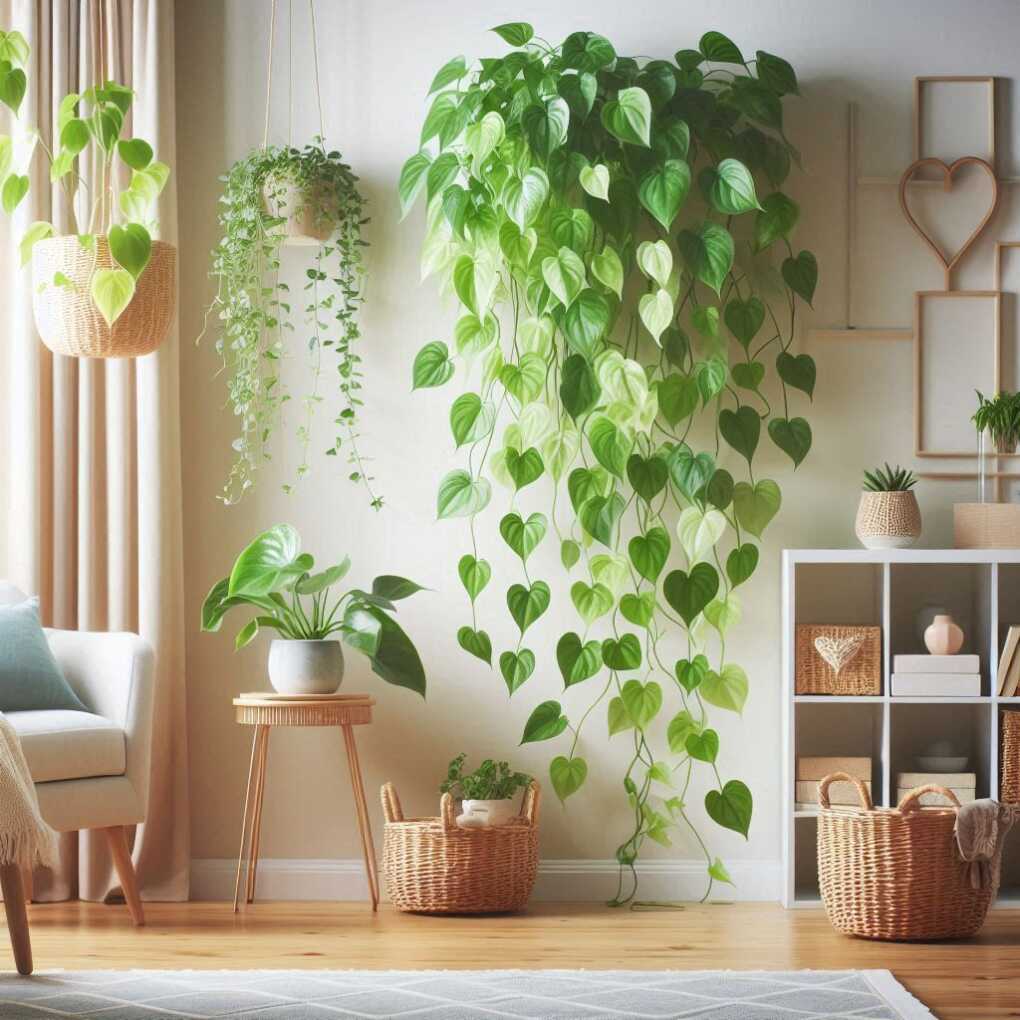
Pothos Propagation Guide:
- Cut a stem below a node, ensuring at least 2-3 leaves on the cutting
- Remove the lowest leaf, exposing the node
- Place the cutting in water or moist soil
- Roots will develop in 2-3 weeks
- Once roots are 1-2 inches long, plant in soil (if water propagated)
Pro Tip: Rotate your pothos regularly to ensure even growth and prevent it from becoming too leggy on one side.
19. Philodendron Scandens (Heart-Leaf Philodendron)
The heart-leaf philodendron is a timeless indoor vine with large, glossy leaves and a trailing habit. It’s a great choice for adding a touch of tropical flair to any room and can be trained to climb or allowed to cascade from shelves and planters.
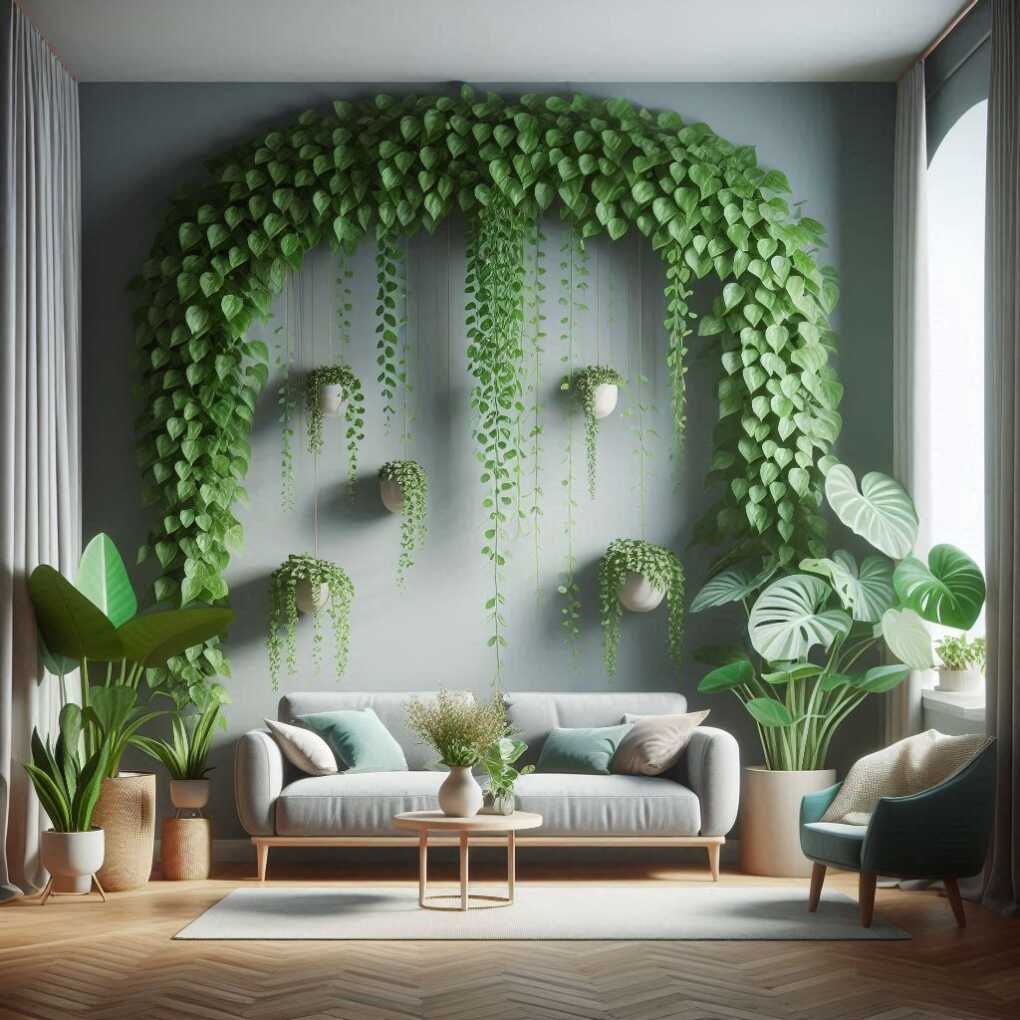
Styling Ideas:
- Train it up a moss pole for a dramatic vertical display
- Let it trail from a high shelf or bookcase
- Use it in a kokedama (Japanese moss ball) for a unique presentation
Pro Tip: To encourage fuller growth, pinch off the growing tips regularly. This will promote branching and create a bushier appearance.
Commercial Product: American Plant Exchange Heart Leaf Philodendron
20. Monstera Adansonii (Swiss Cheese Vine)
The Swiss cheese vine, or Monstera adansonii, is a stunning indoor vine with large, perforated leaves that resemble Swiss cheese. It can be trained to climb up a trellis or allowed to trail gracefully from shelves and hanging baskets.
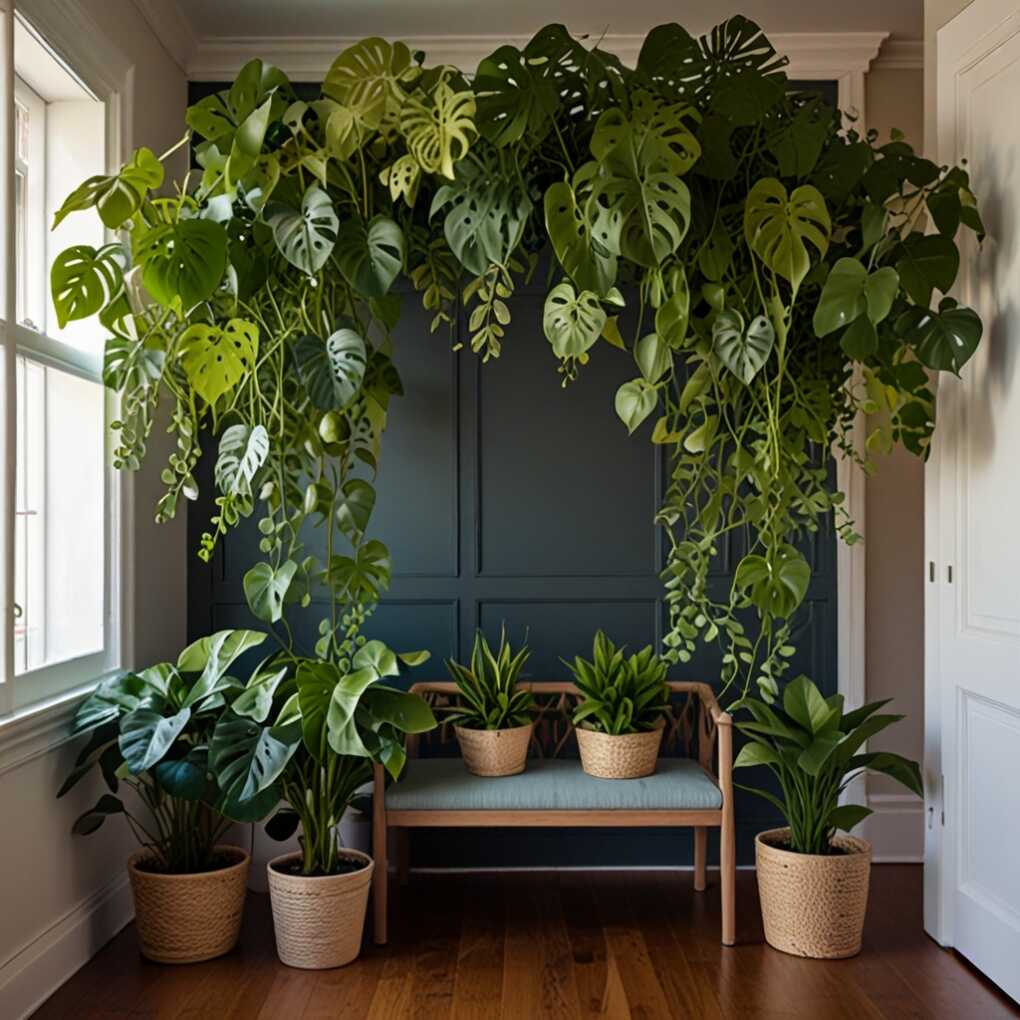
Growth Tips:
- Provide a moss pole or trellis for support
- Mist regularly to increase humidity
- Fertilize monthly during the growing season
- Prune occasionally to maintain desired shape
Pro Tip: To encourage larger leaves with more fenestrations, provide bright indirect light and a support structure for the plant to climb.
21. Peperomia Prostrata (Trailing Jade)
The trailing jade, or Peperomia prostrata, is a charming indoor vine with small, round, succulent-like leaves. Its trailing habit makes it perfect for hanging baskets, shelves, or even as a centerpiece in a terrarium.
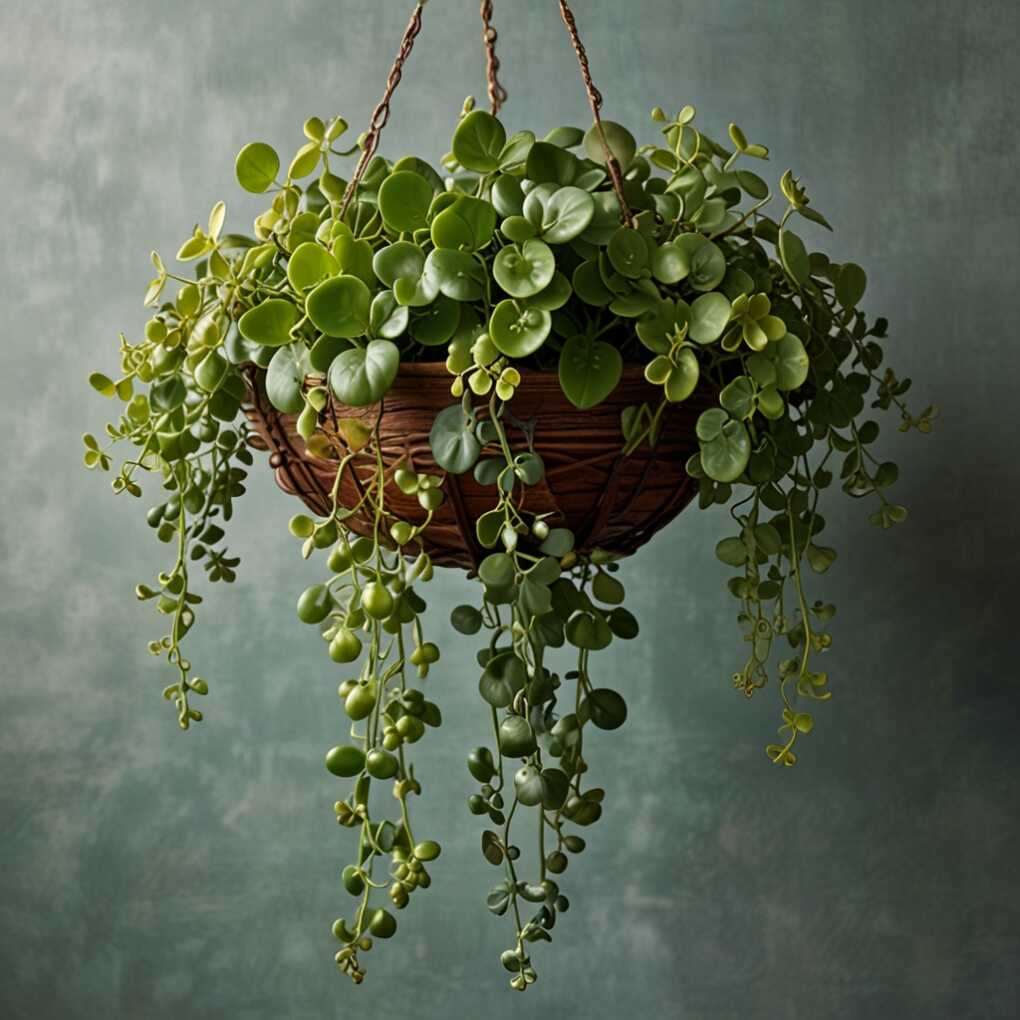
Terrarium Ideas:
- Create a miniature forest scene with moss and small figurines
- Pair with other small succulents for a desert-inspired look
- Use as ground cover in a larger terrarium with taller plants
Pro Tip: While Peperomia prostrata enjoys bright light, direct sunlight can scorch its delicate leaves. Place it in a spot with bright, indirect light for best results.
Commercial Product: The Next Gardener Peperomia Prostrata
22. Senecio Rowleyanus (String of Bananas)
The string of bananas, a relative of the string of pearls, is a unique and eye-catching indoor vine. Its trailing stems are adorned with small, banana-shaped leaves that create a whimsical, cascading effect.
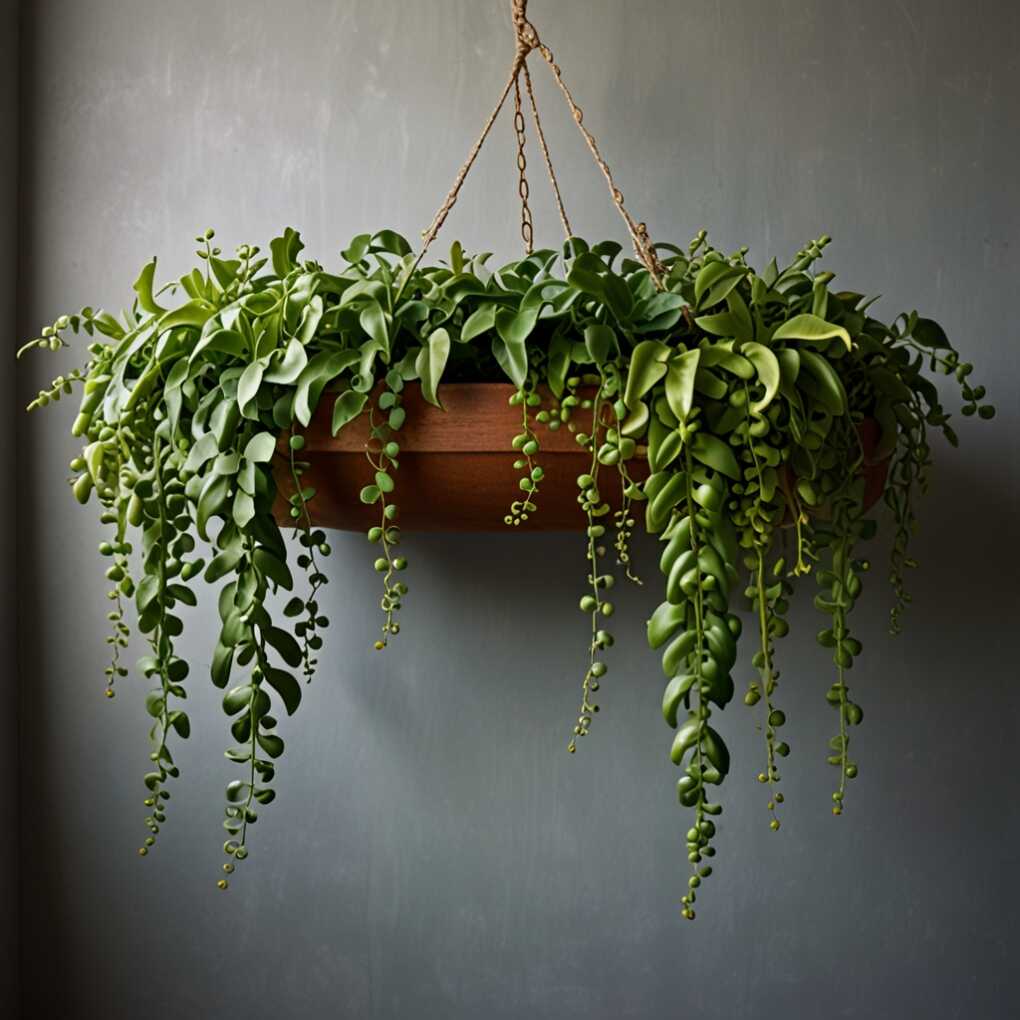
Care Guide:
- Light: Bright, indirect light
- Water: Allow soil to dry between waterings
- Soil: Well-draining succulent mix
- Temperature: 70-80°F (21-27°C)
Pro Tip: To encourage fuller growth, gently coil some of the longer strands back into the pot. They will root and create a denser appearance.
23. Ceropegia Woodii (Rosary Vine)
The rosary vine, or Ceropegia woodii, is a delicate and intriguing indoor vine. Its trailing stems are dotted with small, heart-shaped leaves that resemble a string of rosary beads, making it a captivating addition to any space.
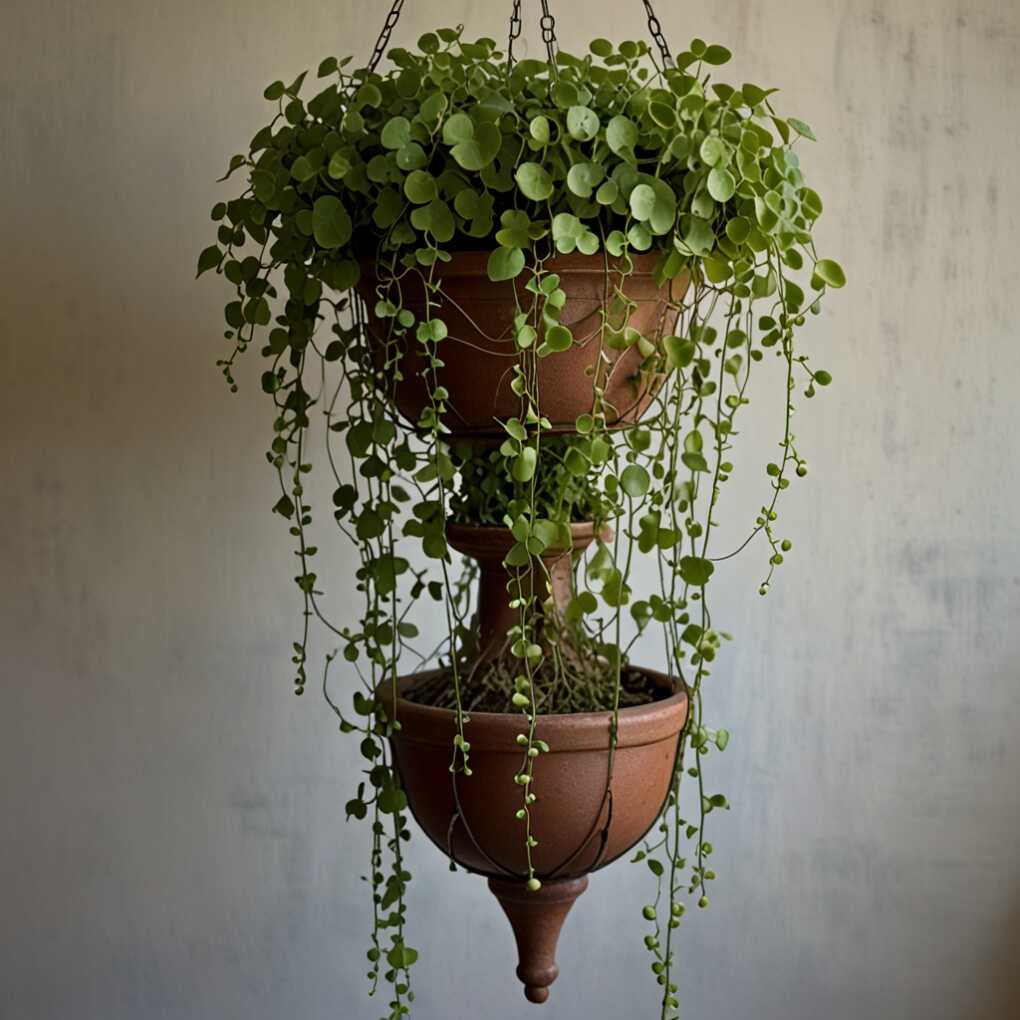
Propagation Method:
- Cut a 4-6 inch section of healthy stem
- Remove leaves from the bottom 2 inches
- Let the cutting dry for a day to callous
- Plant in well-draining soil
- Water sparingly until roots establish
Pro Tip: The rosary vine produces tubers along its stems. These can be planted to create new plants, adding to your collection or making great gifts for fellow plant enthusiasts.
Commercial Product: Hirt’s Gardens String of Hearts Plant
24. Tradescantia Fluminensis (Wandering Dude)
The wandering dude, or Tradescantia fluminensis, is a vibrant and easy-to-grow indoor vine. Its trailing stems are adorned with lush, green leaves that can be trained to climb or allowed to cascade from shelves and baskets.
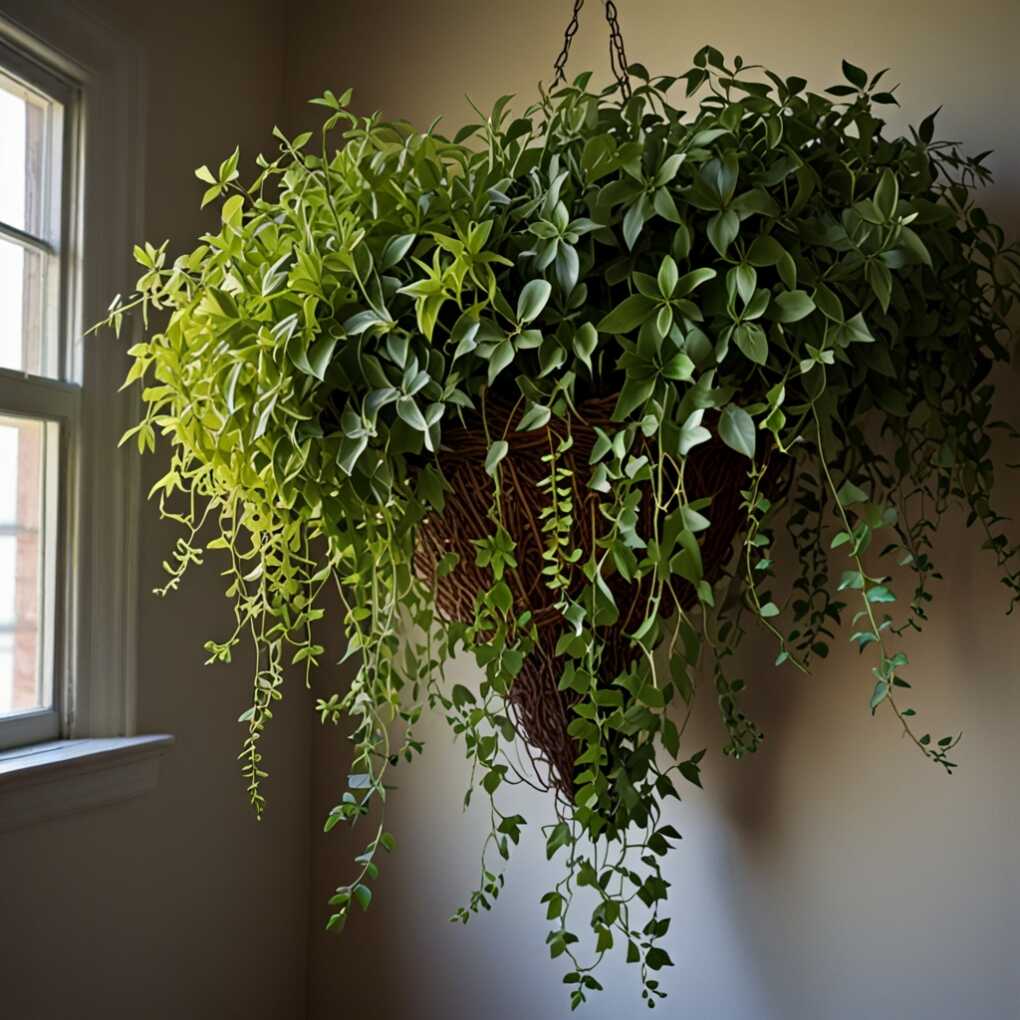
Variegated Varieties:
- ‘Variegata’ – green and white striped leaves
- ‘Quicksilver’ – silver and green leaves
- ‘Lilac’ – purple and green foliage
Pro Tip: To maintain the vibrant colors of variegated varieties, ensure your plant receives plenty of bright, indirect light. Lower light conditions can cause the colors to fade.
25. Hoya Kerrii (Sweetheart Hoya)
The sweetheart hoya, with its iconic heart-shaped leaves and delicate, star-shaped flowers, is a charming and romantic indoor vine. It can be trained to climb or displayed in hanging baskets, adding a touch of whimsy to any space.
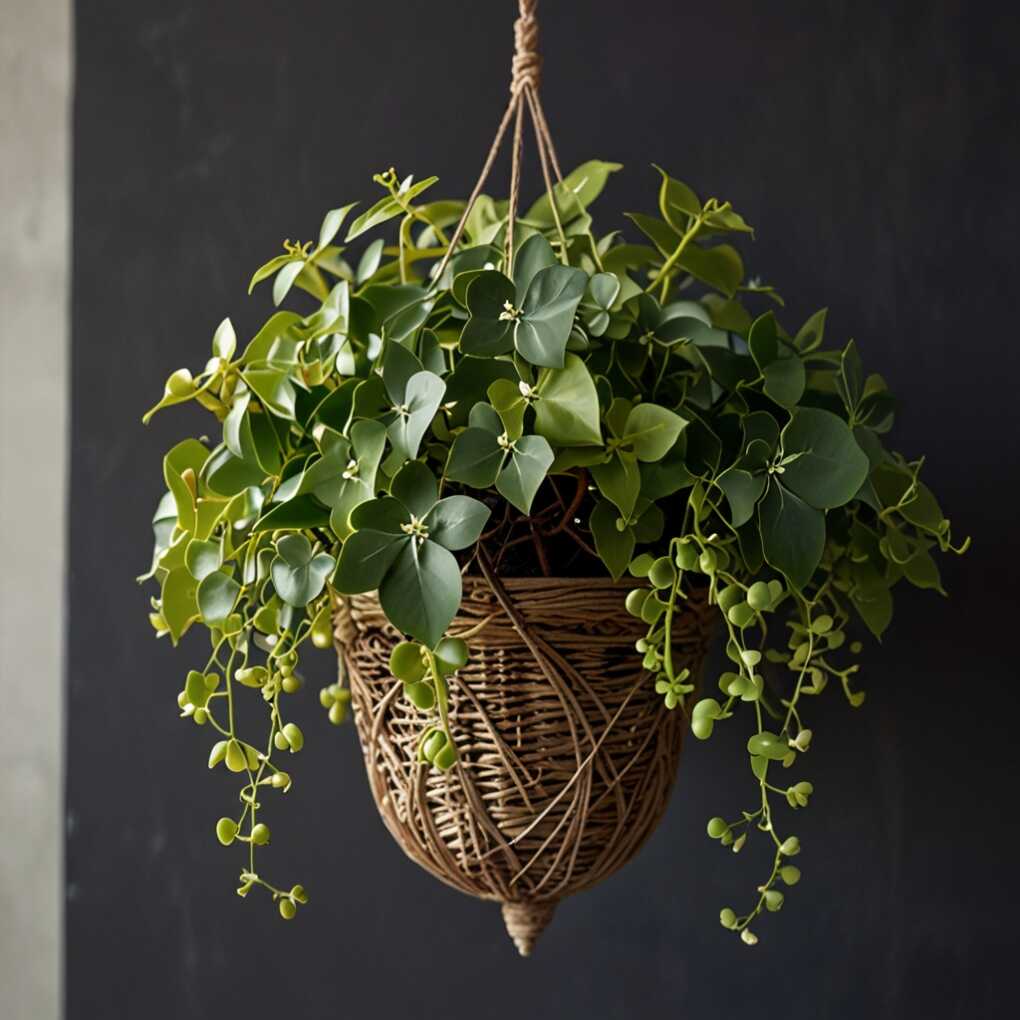
Valentine’s Day Gift Idea:
Single-leaf Hoya kerrii plants are often sold around Valentine’s Day. While cute, these rarely grow into full plants. For a longer-lasting gift, opt for a more mature plant with multiple leaves.
Pro Tip: Hoya kerrii is a slow grower, so be patient. Provide bright, indirect light and allow the soil to dry between waterings to prevent root rot.
Commercial Product: Costa Farms Live Hoya Heart Plant
26. Peperomia Prostrata (Trailing Peperomia)
The trailing peperomia, with its small, round leaves and trailing habit, is a delightful addition to any indoor vine display. This low-maintenance plant thrives in bright, indirect light and can be grown in hanging baskets or on shelves.
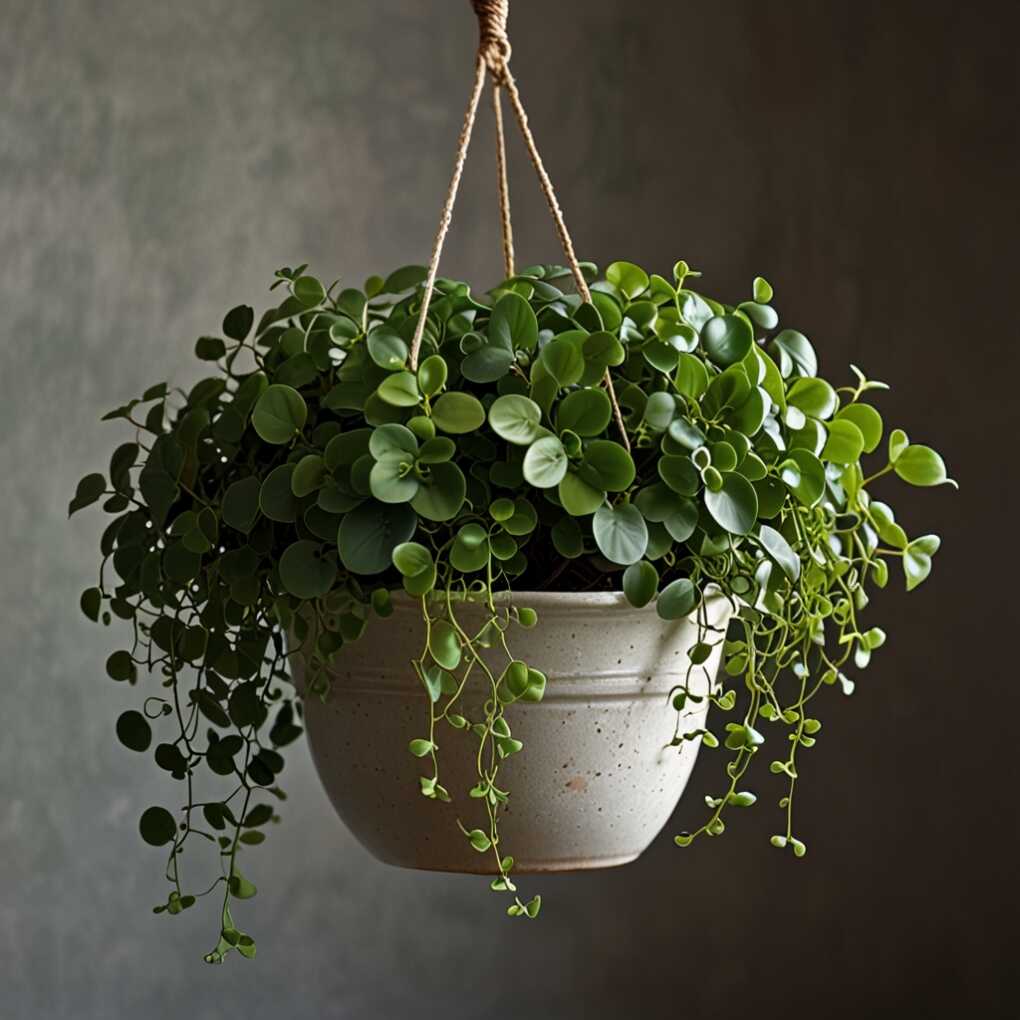
Styling Ideas:
- Create a living wall with multiple plants in wall-mounted planters
- Use as a spiller in a mixed container arrangement
- Display in a hanging kokedama for a modern, minimalist look
Pro Tip: Peperomia prostrata can be sensitive to overwatering. Allow the soil to dry out completely between waterings to prevent root rot.
27. Dischidia Ruscifolia (Dischidia)
The dischidia, or Hindu rope plant, is a unique and captivating indoor vine. Its long, trailing stems are adorned with small, succulent-like leaves that create a mesmerizing, cascading effect.
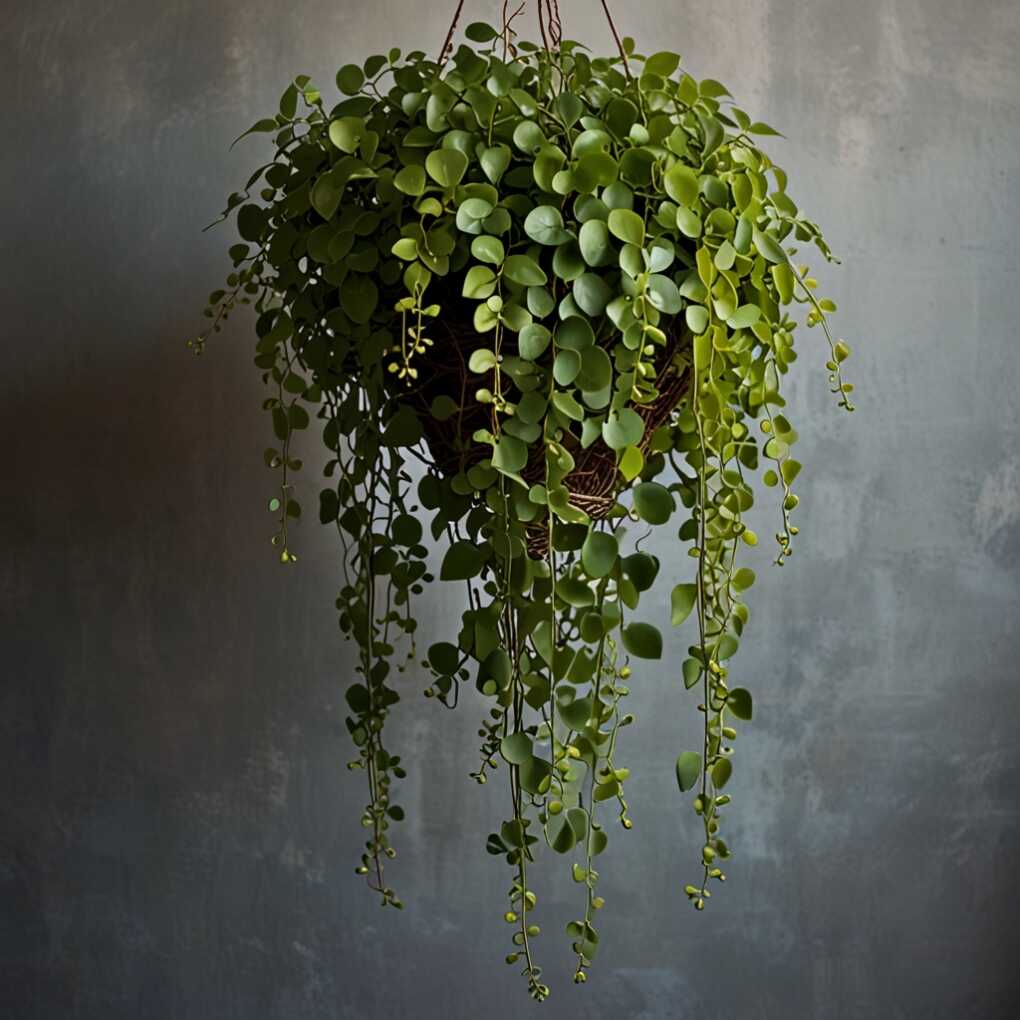
Mounting Ideas:
- Attach to a piece of driftwood for a natural look
- Mount on a cork bark slab
- Grow in a hanging coconut shell planter
Pro Tip: As an epiphyte, Dischidia ruscifolia prefers high humidity. Consider placing it in a bathroom or kitchen, or use a pebble tray to increase humidity around the plant.
Commercial Product: Hirt’s Gardens Dischidia Ruscifolia Billion Hearts
28. Rhipsalis Baccifera (Mistletoe Cactus)
The mistletoe cactus, or Rhipsalis baccifera, is a fascinating indoor vine with segmented, trailing stems and delicate, white flowers. This plant thrives in bright, indirect light and can be displayed in hanging baskets or on shelves.
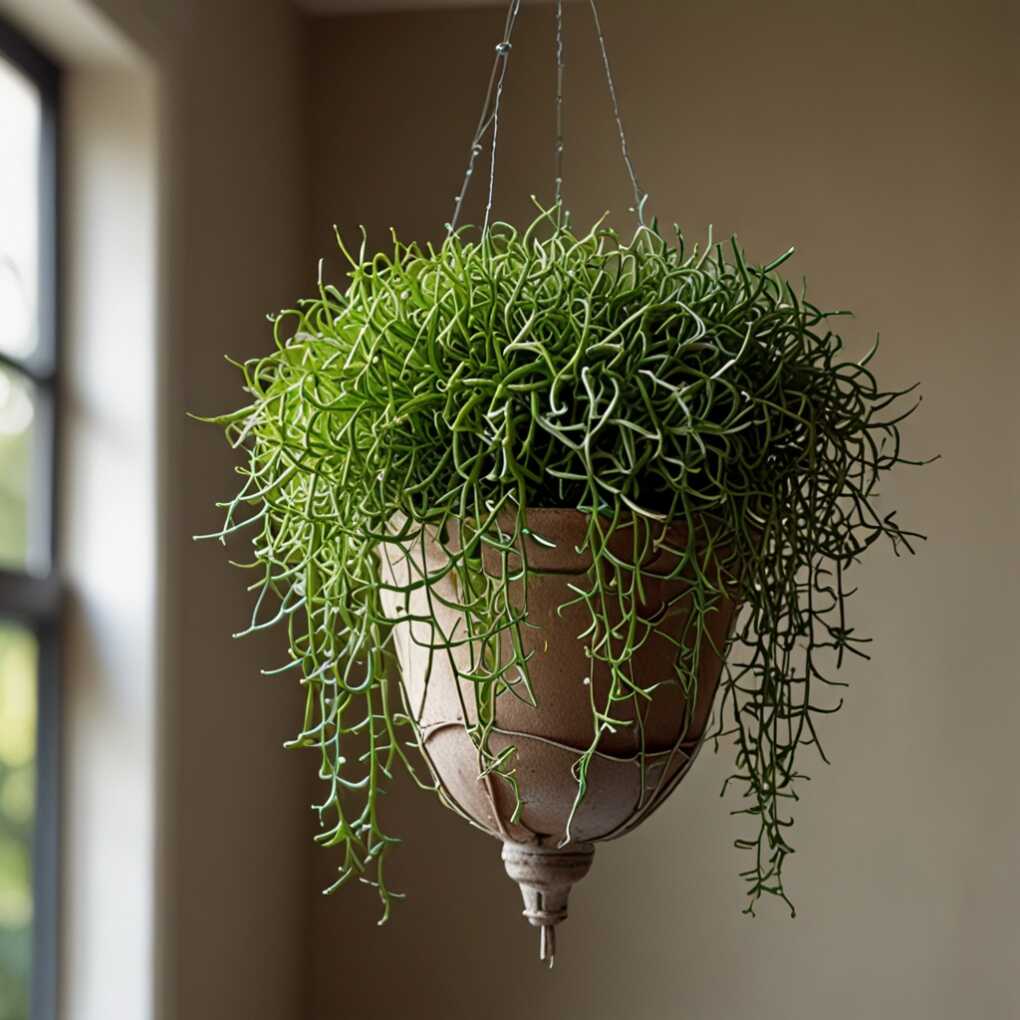
Care Instructions:
- Light: Bright, indirect light
- Water: Allow soil to dry between waterings
- Soil: Well-draining cactus mix
- Humidity: Moderate to high
Pro Tip: While Rhipsalis is a cactus, it’s native to tropical rainforests and prefers more water and humidity than desert cacti. Mist regularly to increase humidity.
29. Senecio Rowleyanus (String of Nickels)
The string of nickels, a relative of the string of pearls, is a charming and whimsical indoor vine. Its trailing stems are dotted with small, round, coin-like leaves that create a captivating, cascading effect.
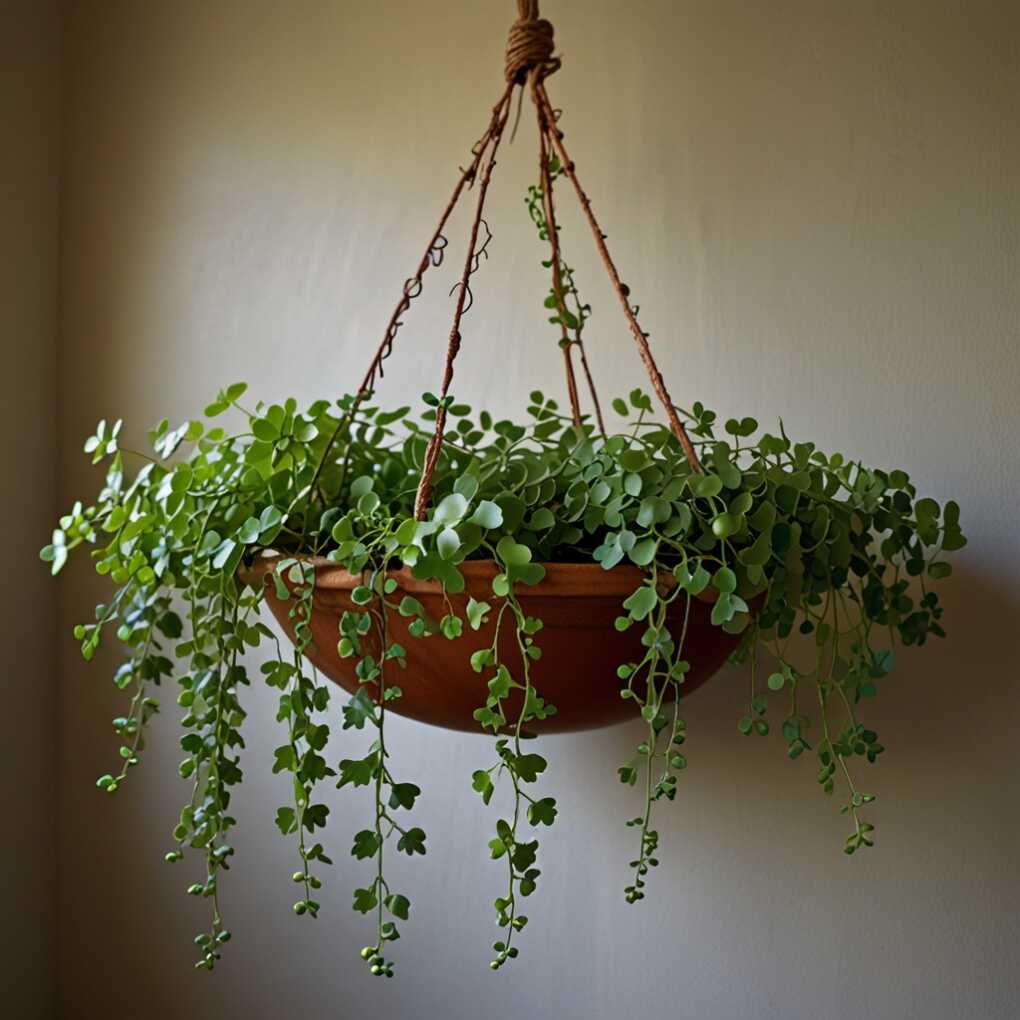
Propagation Method:
- Cut a healthy stem 4-6 inches long
- Remove leaves from the bottom 2 inches
- Allow the cut end to callous for a day
- Plant in well-draining succulent soil
- Water sparingly until roots establish
Pro Tip: Like other succulent vines, the string of nickels is prone to overwatering. Use a terracotta pot to help excess moisture evaporate more quickly.
30. Ceropegia Woodii (Rosary Vine)
The rosary vine, or Ceropegia woodii, is a delicate and intriguing indoor vine. Its trailing stems are adorned with small, heart-shaped leaves that resemble a string of rosary beads, making it a unique and eye-catching addition to any space.
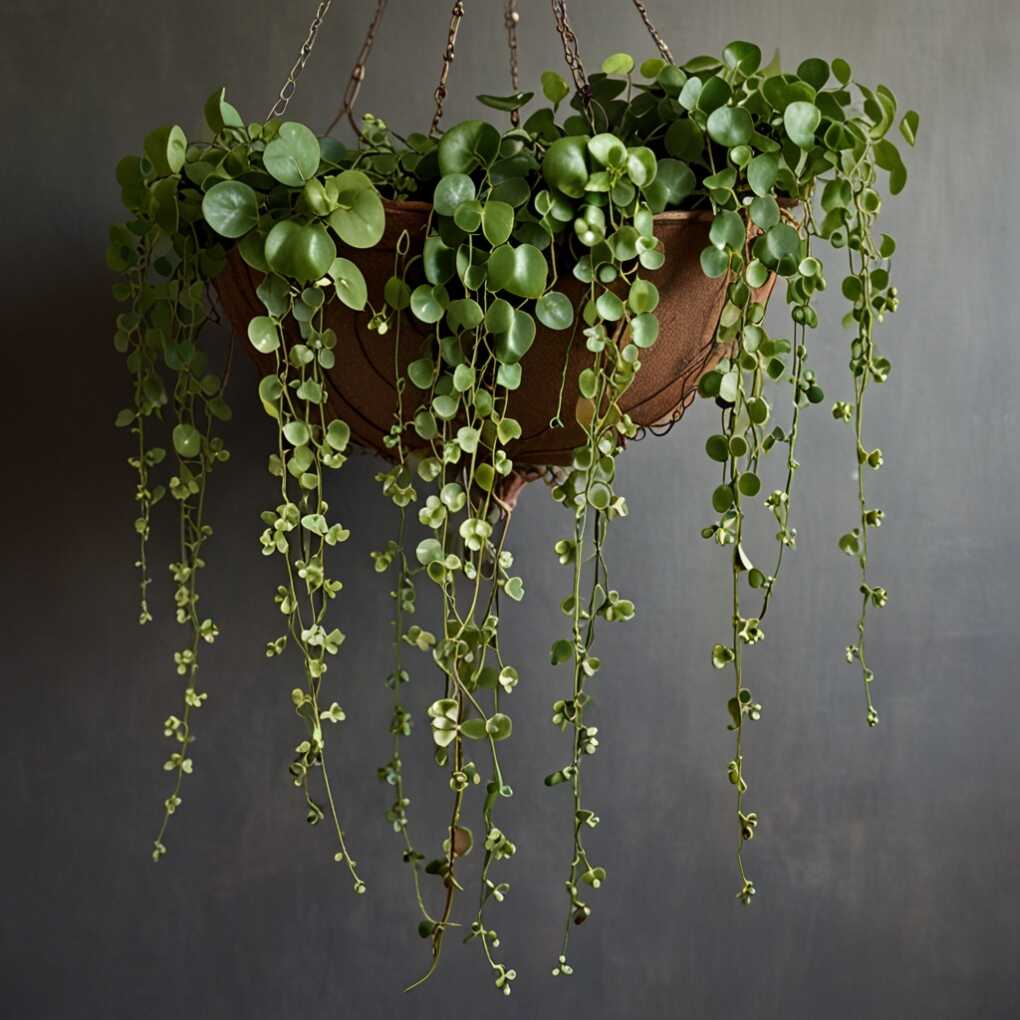
Unique Display Ideas:
- Train it to grow around a wire frame shaped like a heart or star
- Let it cascade from a tall, narrow vase for a waterfall effect
- Grow it in a hanging glass globe terrarium
Pro Tip: The rosary vine produces small tubers along its stems. These can be planted to create new plants, making it easy to expand your collection or share with friends.
Certainly, I’ll continue expanding the blog post in the same style:
31. Tradescantia Zebrina (Purple Heart)
The purple heart, or Tradescantia zebrina, is a vibrant and easy-to-grow indoor vine. Its trailing stems are adorned with striking, purple-and-green striped leaves that add a pop of color to any room.
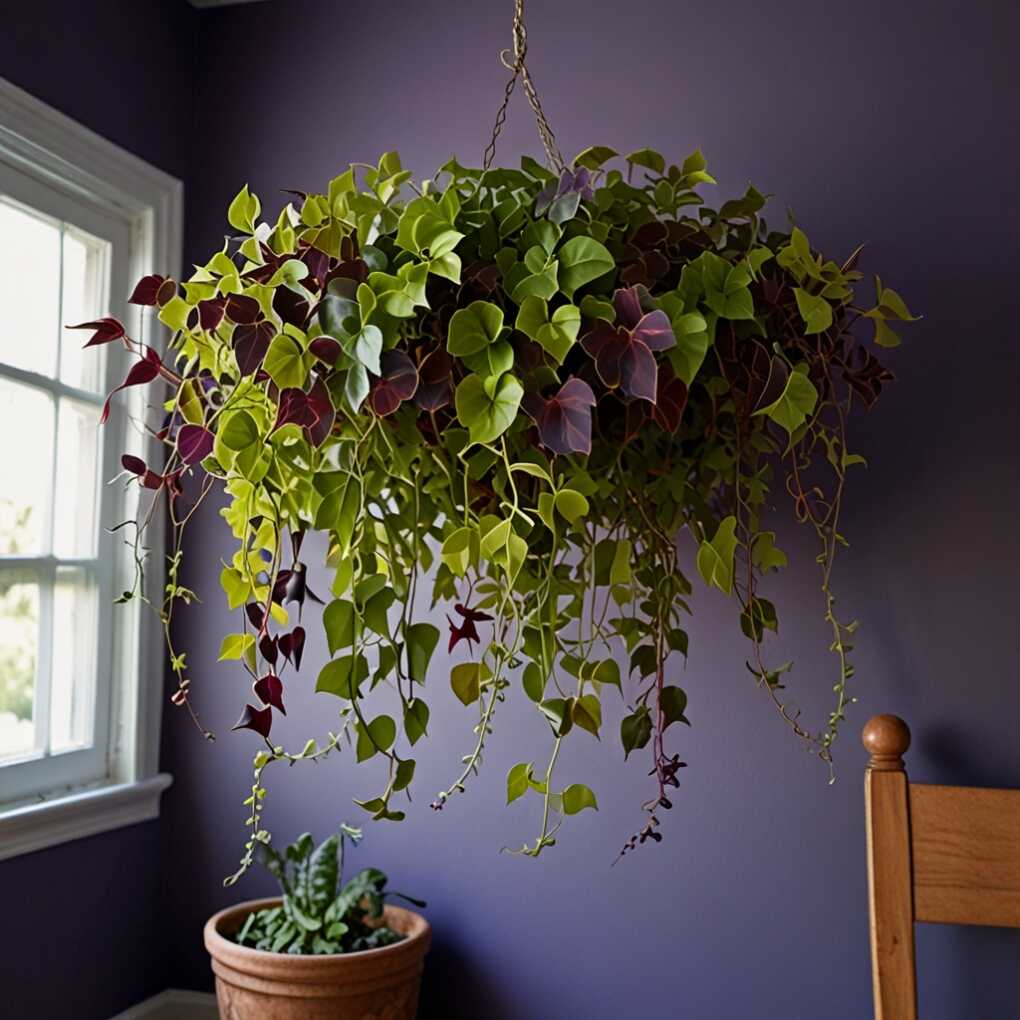
Color Variations:
- ‘Purple Heart’ – deep purple leaves with silvery stripes
- ‘Red Hill’ – burgundy leaves with silver stripes
- ‘Quadricolor’ – green, pink, white, and purple variegation
Pro Tip: To maintain the vibrant purple color, ensure your plant receives plenty of bright, indirect light. In lower light conditions, the leaves may revert to a more green color.
Commercial Product: Tradescantia Zebrina Purple Heart Plant
32. Hoya Carnosa (Wax Plant)
The wax plant, or Hoya carnosa, is a stunning indoor vine with thick, waxy leaves and delicate, star-shaped flowers. These plants can be trained to climb trellises or allowed to trail gracefully from shelves and planters.
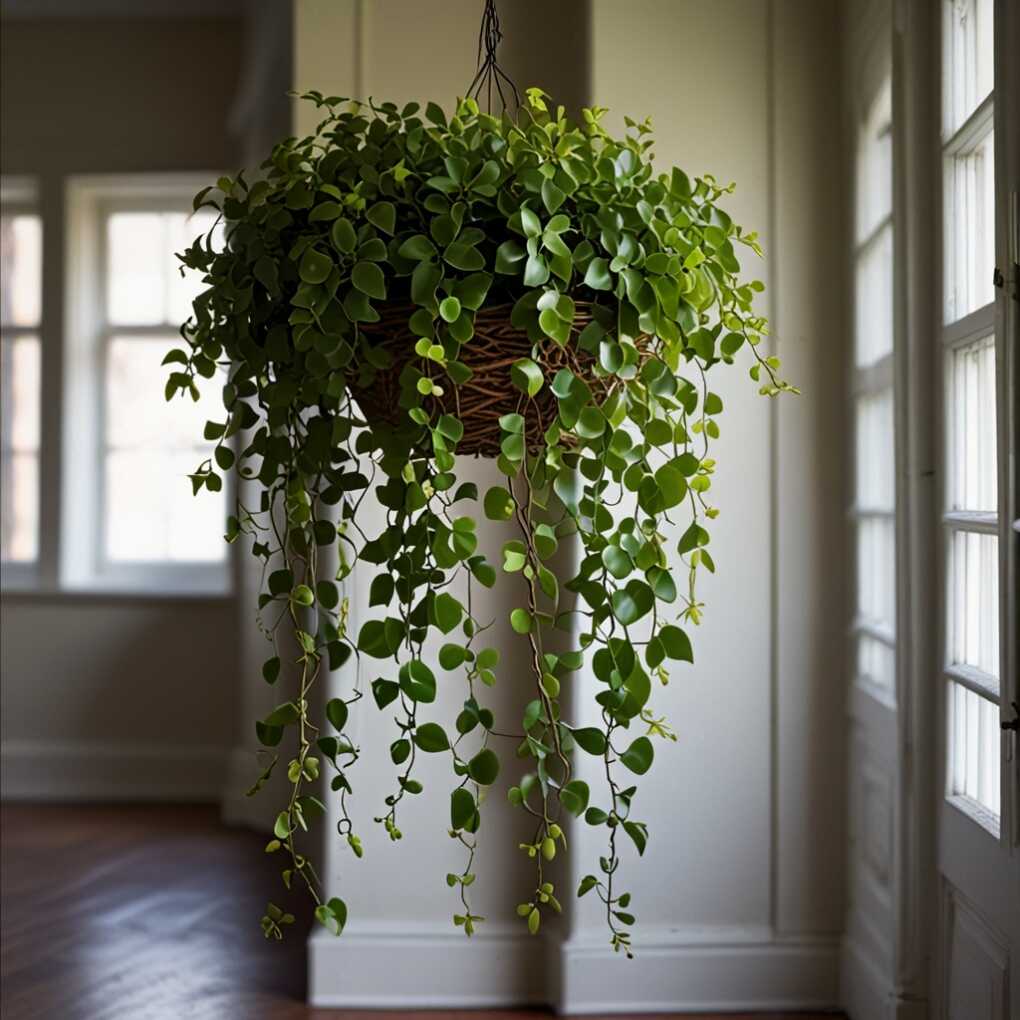
Flowering Tips:
- Provide bright, indirect light
- Allow the plant to become slightly root-bound
- Maintain consistent temperatures (60-80°F / 15-27°C)
- Feed with a high-phosphorus fertilizer during growing season
Pro Tip: Don’t remove the peduncles (flower stalks) after blooming. Hoyas often rebloom from the same peduncles year after year.
33. Scindapsus Pictus (Satin Pothos)
The satin pothos, with its silvery-green, heart-shaped leaves and trailing vines, is a beautiful and low-maintenance indoor vine. It thrives in bright, indirect light and can be displayed in hanging baskets or on shelves.
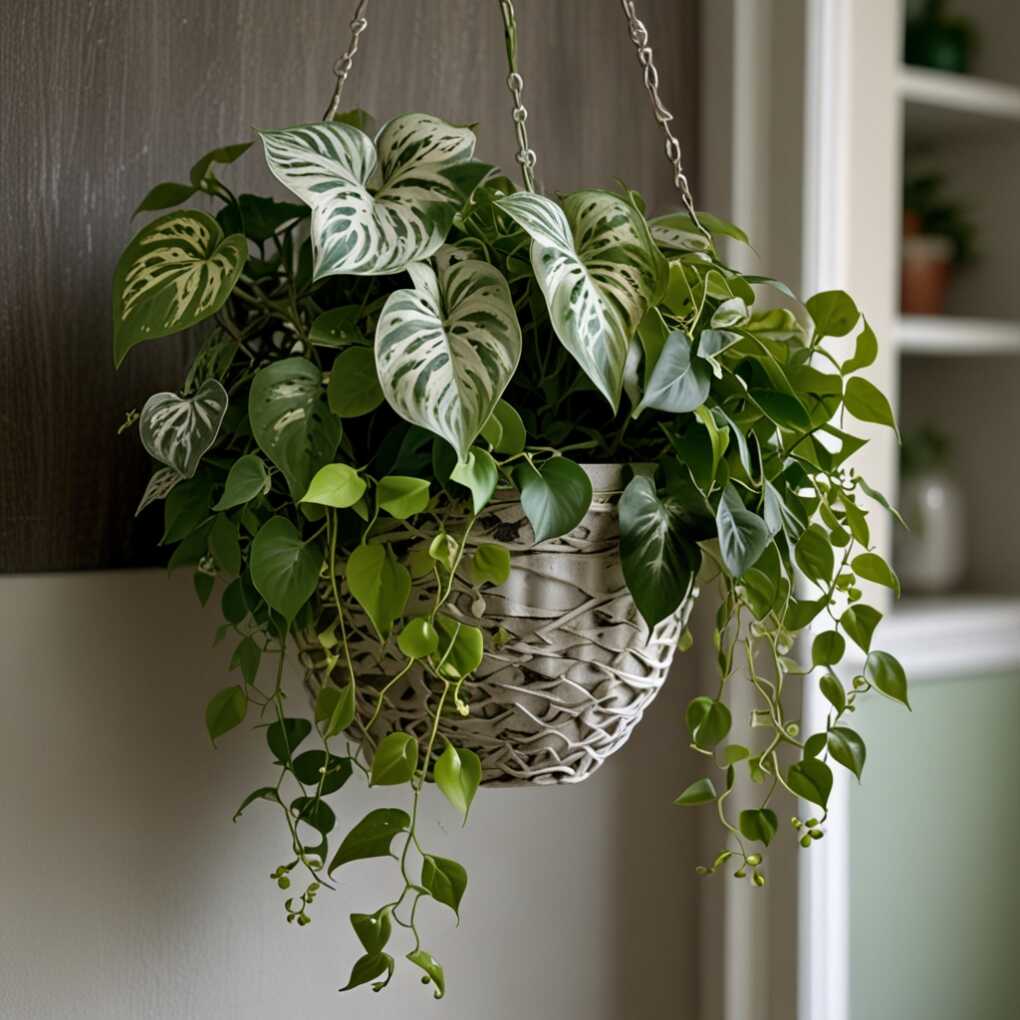
Varieties:
- ‘Argyraeus’ – small silver spots on dark green leaves
- ‘Exotica’ – larger silver patches on dark green leaves
- ‘Silver Ann’ – leaves almost entirely silver
Pro Tip: To encourage fuller growth, pinch off the growing tips regularly. This will promote branching and create a bushier appearance.
Commercial Product: American Plant Exchange Satin Pothos
34. Epipremnum Aureum (Neon Pothos)
The neon pothos is a vibrant and eye-catching indoor vine with bright, chartreuse-colored leaves and a trailing habit. It’s a great choice for adding a pop of color to any space and can be trained to climb or allowed to cascade from shelves and planters.
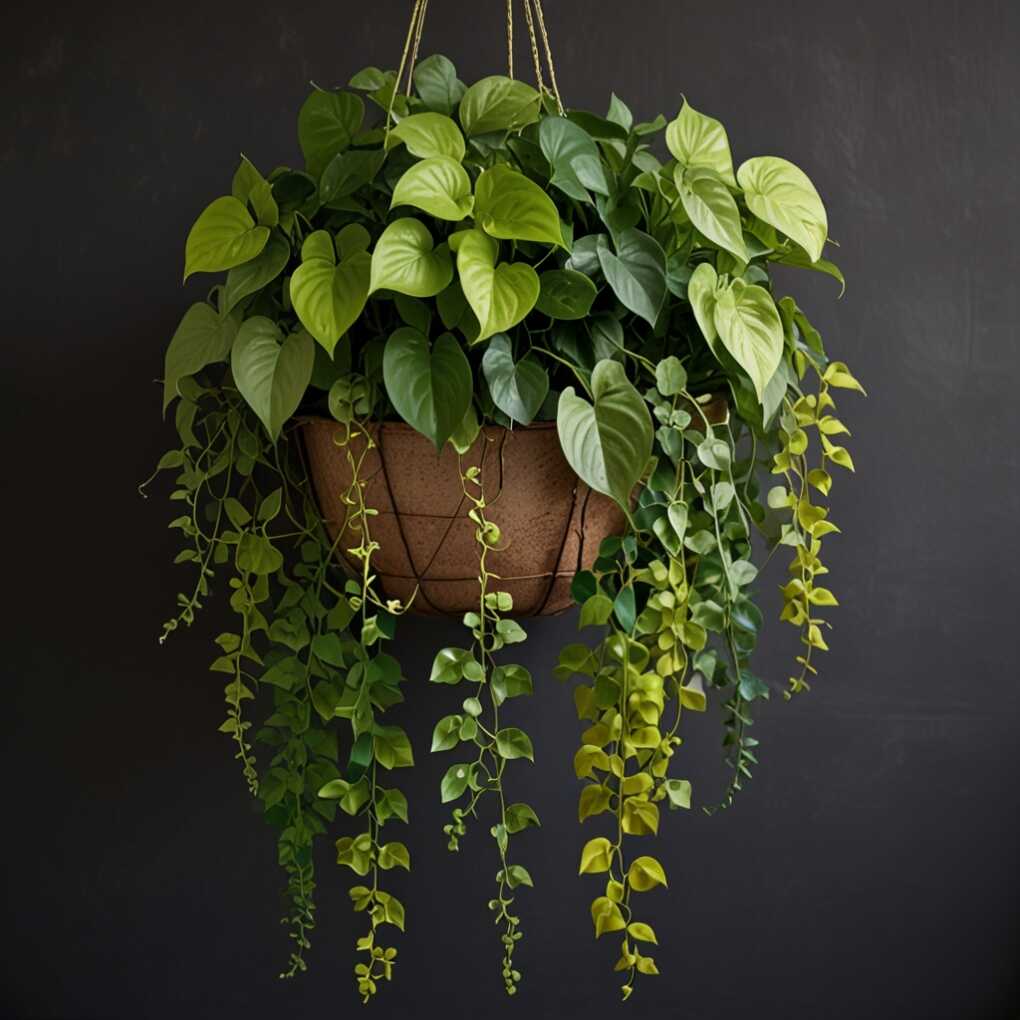
Care Guide:
- Light: Medium to bright indirect light
- Water: Allow top inch of soil to dry between waterings
- Soil: Well-draining potting mix
- Fertilizer: Balanced, water-soluble fertilizer monthly during growing season
Pro Tip: The brighter the light (without direct sun), the more vibrant the neon color will be. In lower light conditions, the leaves may become more green.
35. Philodendron Scandens (Brasil Philodendron)
The Brasil philodendron is a stunning indoor vine with large, glossy leaves that feature a unique, variegated pattern of green and yellow. Its trailing habit makes it perfect for hanging baskets, shelves, or even as a centerpiece in a larger plant display.
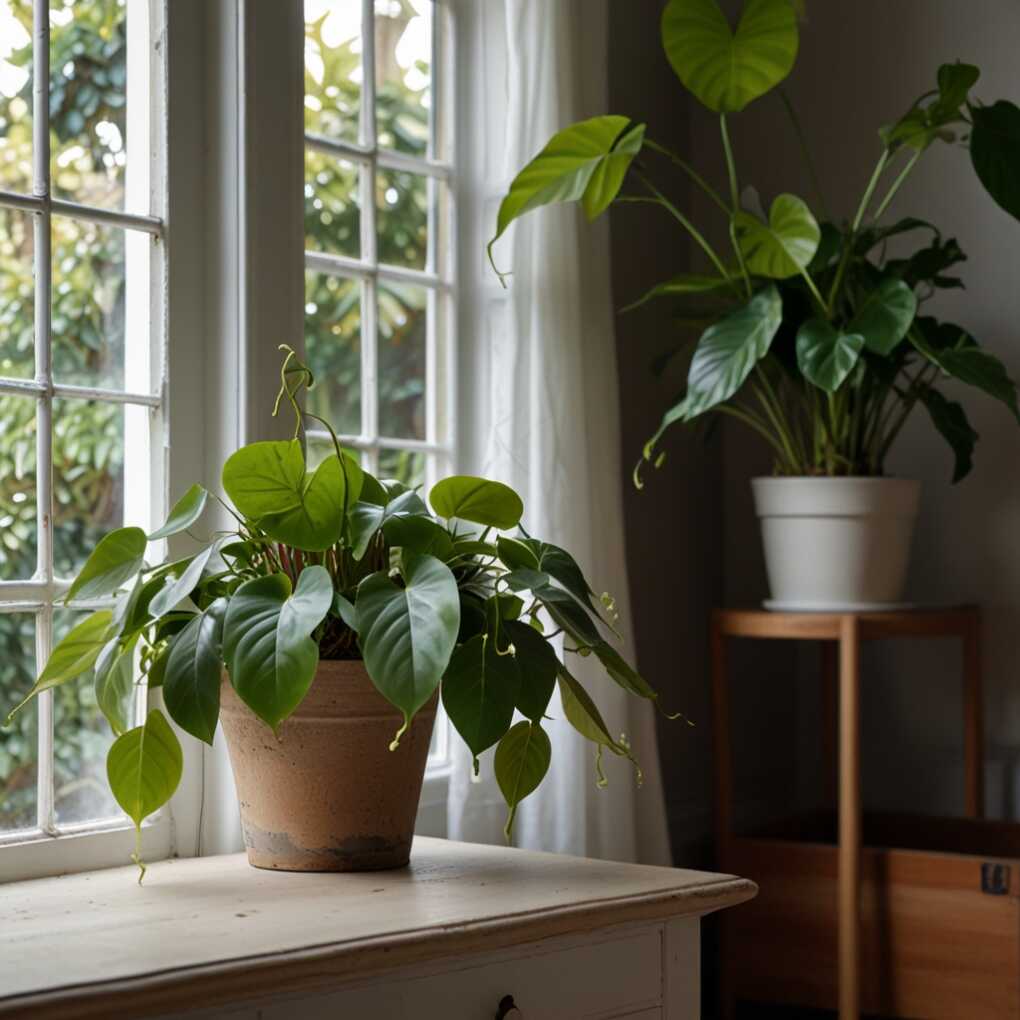
Variegation Maintenance:
- Provide bright, indirect light
- Avoid overfeeding, which can cause loss of variegation
- Prune any all-green leaves to maintain the variegated pattern
- Rotate the plant regularly for even growth and color distribution
Pro Tip: If your Brasil philodendron is producing mostly green leaves, it may need more light. Move it to a brighter location (but avoid direct sunlight) to encourage more variegation.
Commercial Product: Costa Farms Brasil Philodendron
Conclusion
These 35 indoor vine ideas offer a diverse range of options to suit any style or space. Whether you’re looking to add a touch of greenery, create a lush, tropical vibe, or simply elevate your decor, these versatile and eye-catching plants are sure to inspire. Experiment with different combinations, display methods, and care requirements to find the perfect indoor vine (or vines!) for your home.
General Pro Tips for Indoor Vine Care
- Watering: Most indoor vines prefer to dry out slightly between waterings. Always check the soil moisture before watering.
- Light: While many vines tolerate low light, most thrive in bright, indirect light. Avoid direct sunlight, which can scorch leaves.
- Humidity: Many tropical vines appreciate higher humidity. Consider using a pebble tray or humidifier to increase moisture in the air.
- Pruning: Regular pruning encourages fuller growth and helps maintain the desired shape of your vines.
- Support: Provide trellises, moss poles, or other supports for climbing vines to encourage healthy growth.
- Rotation: Rotate your plants regularly to ensure even growth and prevent them from growing lopsided.
- Pest Control: Regularly inspect your vines for common pests like spider mites, mealybugs, and scale. Treat promptly if detected.
- Cleaning: Dust leaves gently with a damp cloth to keep them clean and allow for better photosynthesis.
Remember, each plant is unique and may have specific care requirements. Always research the particular needs of your chosen vine species for the best results. Happy gardening!
